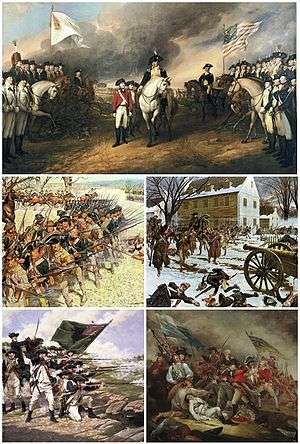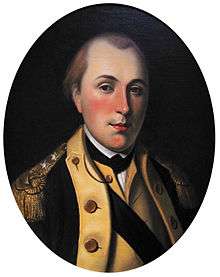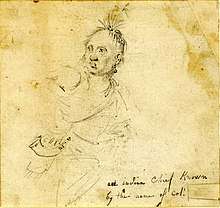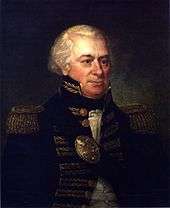American Revolutionary War
The American Revolutionary War (1775–1783), also known as the American War of Independence, was initiated by the thirteen original colonies in Congress against the Kingdom of Great Britain over their objection to Parliament's direct taxation and its lack of colonial representation.[lower-alpha 18] The overthrow of British rule established the United States of America as the first republic in modern history extending over a large territory.[lower-alpha 19]
Early British policy for empire in North America was one of salutary neglect. It largely left the settlers there alone to govern themselves. After 1763 Britain gained a new expanded Empire, and Parliament turned to the Navigation Acts to increase revenues. That provoked unrest among the Thirteen Colonies that continued into the next decade. To punish the 1773 Boston Tea Party, Parliament's Intolerable Acts closed the port of Boston and suspended their colonial legislature, as Royal Governors then did elsewhere. Twelve colonial house assemblies sent delegates to the First Continental Congress.[lower-alpha 20] It coordinated a systematic boycott of British goods, then called for a second congress. The Second Continental Congress appointed George Washington in June 1775 as its commander in chief to create a Continental Army and to oversee the Siege of Boston. Their July 1775 Olive Branch Petition was answered by King George III with a Proclamation of Rebellion. Congress then passed the Declaration of Independence in July 1776.
After evicting the British from Boston in 1775, Congress then sponsored an attack on British Quebec, but it failed. The British commander in chief, General Sir William Howe then launched a British counter-offensive, capturing New York City. Washington retaliated with harassing attacks at Trenton and Princeton. Howe's 1777–78 Philadelphia campaign captured that city, but the British lost an invading army at Saratoga in October 1777. At Valley Forge that winter, Washington built a professional army. The American victory at Saratoga convinced the French to enter into treaties for trade and to defend US independence from Britain in 1778.
Spanish Louisiana Governor Bernardo Gálvez routed British forces from Spanish territory. This allowed supplies north from the Spanish and American privateers for the 1779 Virginia militia conquest of Western Quebec (later the US Northwest Territory).[34] He then expelled British forces from Mobile, Alabama and Pensacola, cutting off British military assistance to their Indian allies in the interior South. Howe's replacement, General Sir Henry Clinton, then mounted a 1778 "Southern strategy" from Charleston. After initial success taking Savannah, their losses at King's Mountain and Cowpens led to the British southern army retreat to Yorktown. A decisive French naval victory brought the October 1781 surrender of the second British army lost in the American Revolution.
In early 1782, Parliament voted to end all offensive operations in America, and in December 1782 George III spoke from the British throne for US independence. In April 1783, Congress accepted the British-proposed treaty that met its peace demands including independence and sovereignty west to the Mississippi River. On September 3, 1783, the Treaty of Paris was signed between Great Britain and the United States, recognizing the United States, making peace between the two nations, and formally ending the American Revolution.
Background
Taxation and legislation
Following Cromwell's Interregnum in England after 1649, and then during the Stuart Kings after 1660, early British North American imperial policy was one of benign neglect. And unlike the Spanish colonial government of the same period, the British allowed native-born gentry to become Royal Council members in each colonial legislature.[lower-alpha 21] Following the accession of George III to the throne of Great Britain at the end of the Seven Years' War, Parliament increased revenues through the Navigation Acts to fund the war debt. They also were used to pay for greater administrative costs in the expanded British Empire brought by the territorial settlements at the Peace of Paris (1763). American colonists resented the additional levies from Parliament because their local colonial assemblies had taxed them to contribute to the North American part of the British war, and their county militias had fought against the French and their Indian allies on the frontier.[35]
Parliament passed the Stamp Act as a revenue measure in 1765. That began a new direct internal tax without consent of the local colonial assemblies. American colonial legislatures argued that they had exclusive right to impose taxes within their own jurisdictions.[35] Colonists condemned the tax because their rights as Englishmen protected them from any tax from a Parliament in which they had no elected representatives.[36] Parliament argued that the colonies were "virtually represented", an argument that was criticized throughout the British Empire.[37] The act was repealed in 1766, but Parliament also affirmed its right to pass laws that were binding on the colonies.[38] From 1767, Parliament began passing Townshend Acts to raise additional revenue for new royal officials to enforce a merchantile policy. It enacted new taxes on tea, lead, glass, and paper.[39][40]

destruction of British tea at Boston Harbor[41][lower-alpha 22]
Collecting revenues proved difficult, even with new writs of assistance that gave the Crown's enforcement officers the power to make unlimited searches of a suspect without a warrant until the next king took the throne. When the British seized the sloop Liberty in 1768 on suspicions of smuggling, it triggered a riot. British troops were landed to occupy Boston and restore order. Seven years after the 1763 Peace, four consecutive Whig governments had overseen continuously declining relations in the American colonies. In 1770, the Tory Lord North gained office; he would be Prime Minister to George III through to the end of the Revolution, when the British defeat at Yorktown forced North's resignation. Enacting Lord North's tougher policy in America, Parliament threatened to extradite colonists to face trial in England as traitors, and tensions escalated when British garrison troops subsequently fired on rock-throwing civilians at the Boston Massacre.[42]
In 1772, Rhode Islanders boarded and burned a customs schooner. In an effort to quiet colonial unrest, Parliament then repealed all taxes except the one on tea, passing the Tea Act in 1773. Colonial objections continued, and landing the tea for sale was compromised in all the licensed ports of Charleston, Philadelphia, New York City and Boston. But Boston was singled out as the instigator for the others.[43]
At the widespread colonial resistance to its supremacy, Parliament reacted with punitive legislation. It closed Boston Harbor and the Royal Governor dissolved the independent colonial legislature. Other Royal Governors followed suit.[44][45] Further measures allowed the extradition of American colonial officials for trial elsewhere in the British Empire. The Quartering Act allowed occupying British troops in private homes without the owner's permission.[46][lower-alpha 23] The colonists referred to the measures as the "Intolerable Acts", and they argued that the constitutional rights of their English Charters and their natural rights as free men were being violated.[47] The acts were widely opposed among most colonial legislatures, where Patriots gained support from among neutrals, while Loyalist supporters were quieted.[48]
Colonial response

The elected members in the Royal colonial legislatures, those who represented the smaller landowners in the lower-house assemblies, responded by establishing ad hoc provincial legislatures, variously called Congresses, Conventions and Conferences. They effectively removed Crown control within their respective colonies. Twelve sent representatives to the First Continental Congress to develop a joint American response to the crisis. [lower-alpha 24][49] It passed a compact declaring a trade boycott against Britain.[50][51][lower-alpha 25]
While the Congress also affirmed that Parliament had no authority over internal American matters, they also acquiesced to trade regulations for the benefit of the empire.[lower-alpha 26] Awaiting some measure of reconciliation from Parliament and the King's Tory government, Congress authorized the extralegal committees and conventions of the colonial legislatures to enforce the Congressional boycott. In the event, the boycott was effective, as imports from Britain dropped by 97% in 1775 compared to 1774.[50]
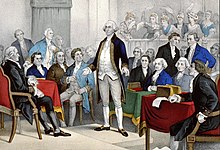
Parliament refused to yield to Congressional proposals. In 1775, it declared Massachusetts to be in a state of rebellion and enforced a blockade of the colony.[52] It then passed the Restraining Acts of 1775 aimed at limiting colonial trade to the British West Indies and the British Isles. New England ships were barred from the Newfoundland cod fisheries. These increasing tensions led to a mutual scramble for ordnance between royal governors and the elected assemblies. British raids on colonial powder magazines pushed the assemblies towards open war. Each assembly was required by law to defend them for the purpose of providing arms and ammunition for frontier defense.[53] Thomas Gage was appointed the British Commander-in-Chief for North America. As military governor of Massachusetts he was ordered to disarm the local militias on April 14, 1775.[54]
War breaks out
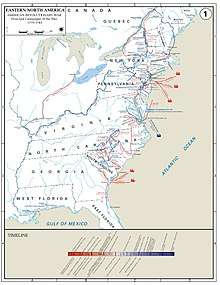
As the American Revolutionary War was to unfold in North America, there were two principal campaign areas within the 13 states, and a smaller but strategically important one west of the Appalachian Mountains to the Mississippi River and north to the Great Lakes. The full-on military campaigning began in the states north of Maryland, and fighting was most frequent and severest there between 1775 and 1778. In the South, Patriots benefitted from early victories at Fort Sullivan and Moore's Creek. After the 1778 Battle of Monmouth, war in the North stalemated into raids, and the main Continental Army watched the British army in New York City. Starting in 1779, the war shifted as the British initiated a new strategy to subdue the southernmost states then move northward. The British maneuvering out of Charleston through battles in South Carolina, North Carolina and into Virginia led to a combined American and French force cornering General Charles Cornwallis at Yorktown and the surrender of his army.[55]
Well known for his accomplishments in the French and Indian War, Washington was unanimously confirmed by the Continental Congress on June 16,[56][57] and he officially assumed command in the field at Cambridge, Massachusetts, on July 3.[58] He designed the overall military strategy of the war in cooperation with Congress, established the principle of civilian supremacy in military affairs, personally recruited his senior office corps and kept the states all pointed toward the common goal.[59][60] For the first three years until after Valley Forge, the Continental Army was largely supplemented by local state militias. At Washington's discretion, the inexperienced officers and untrained troops were employed in a Fabian strategy rather than resorting to frontal assaults against Britain's professional army.[61] During the war Washington lost more battles than he won, but he maintained a fighting force in the face of British field armies and never surrendered his troops.[62]
Acting on intelligence, Gage planned to destroy stores of militia ordnance at Concord by way of Lexington to capture John Hancock and Samuel Adams, the two principle provocateurs of the rebellion. The operation was to commence before midnight while completing their objectives and retreating to Boston before multitudes of patriot militias could respond. However, the patriots also had a good intelligence network, which Paul Revere had helped organize. Subsequently, the Patriots learned of Gage's intentions before he could act, where Revere quickly dispatched this information and alerted Captain John Parker and the patriot forces in Concord.[63][64]
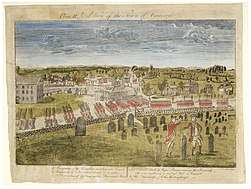
Fighting broke out during the Battles of Lexington and Concord on April 19, when patriots fired the first shot forcing the British troops to conduct a fighting withdrawal to Boston. Overnight, the local militia converged on and laid siege to Boston.[65] On May 25, 4,500 British reinforcements arrived with generals William Howe, John Burgoyne, and Henry Clinton.[66] During the Battle of Bunker Hill the British seized the Charlestown Peninsula on June 17 with a frontal assault costing many officer casualties to American rifle snipers.[67][68] Surviving British commanders were dismayed at the costly attack which had gained them little,[69] and Gage appealed to London stressing the need for a large army to suppress the revolt.[70] Total British losses killed and wounded exceeded 1,000, leading Howe to replace Gage.[71]
Congressional leader John Adams of Massachusetts nominated Virginia delegate George Washington for commander-in-chief of the Continental Army in June 1775. He had previously commanded Virginia militia regiments in British combat commands during the French and Indian War.[72][73] Washington proceeded to Boston to assume field command of the ongoing Siege of Boston on July 3.[58] Howe made no effort to attack in a standoff with Washington,[74] who made no plan to assault the city.[75] Instead, the Americans fortified Dorchester Heights. In early March 1776, Colonel Henry Knox arrived with heavy artillery captured from a raid on Fort Ticonderoga.[76] Under cover of darkness Washington placed his artillery atop Dorchester Heights March 5,[77] threatening Boston and the British ships in the harbor. Howe did not want another battle like Gage's Bunker Hill, so he evacuated Boston. The British were permitted to withdraw without further casualties on March 17, and they sailed to Halifax, Nova Scotia. Washington then moved his army south to New York.[78]
Beginning in August 1775, American Privateers had begun to raid villages in Nova Scotia, first at Saint John, then Charlottetown and Yarmouth. They continued in 1776 at Canso and then a land assault on Fort Cumberland.
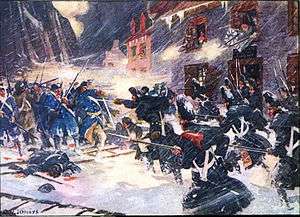
Meanwhile, British officials in Quebec began negotiating with Indian tribes to support them,[79] while the Americans urged them to maintain neutrality.[80][81] In April 1775, Congress feared an Anglo-Indian attack from Canada and authorized an invasion of Quebec. Quebec had a largely Francophone population and had been under British rule for only 12 years.[82][83][lower-alpha 28] A Massachusetts sponsored uprising in Nova Scotia had been disbursed in November, but The Americans expected that they would welcome liberation from the British.[82] The second American expedition into the former French territory was defeated at the Battle of Quebec on December 31.[84][85] After a loose siege, the Americans withdrew on May 6, 1776.[86] An American failed counter-attack on June 8 ended their operations in Quebec.[87] However, British pursuit was blocked by American ships on Lake Champlain until they were cleared on October 11 at the Battle of Valcour Island. The American troops were forced to withdraw to Ticonderoga, ending the campaign. The invasion cost the Patriots their support in British public opinion,[88] and their aggressive anti-Loyalist policies had diluted Canadian support.[89] No further Patriot attempts to invade were subsequently made.[90]
In Virginia, Royal Governor Lord Dunmore had attempted to disarm the militia as tensions increased, although no fighting broke out.[91] He issued a proclamation on November 7, 1775, promising freedom for slaves who fled their Patriot masters to fight for the Crown.[92][93] Dunmore's troops were repulsed at the Battle of Great Bridge, and Dunmore fled to British ships anchored off the nearby port at Norfolk. The Third Virginia Convention refused to disband its militia or accept martial law. Speaker Peyton Randolph in the last Royal Virginia Assembly session did not make a response to Lord Dunmore concerning Parliament's Conciliatory Resolution. Negotiations failed in part because Randolph was also President of the Virginia Conventions, and he deferred to Congress, where he was also President. Dunmore ordered the ship's crews to burn Norfolk on January 1, 1776.[94]

Battle of Sullivan's Island, June 1776
Fighting broke out on November 19 in South Carolina between Loyalist and Patriot militias,[95] and the Loyalists were subsequently driven out of the colony.[96] Loyalists were recruited in North Carolina to reassert colonial rule in the South, but they were decisively defeated and Loyalist sentiment was subdued.[97] A troop of British regulars set out to reconquer South Carolina and launched an attack on Charleston during the Battle of Sullivan's Island, on June 28, 1776,[98] but it failed and left the South in Patriot control until 1780.[99][100]
Shortages in Patriot gunpowder led Congress to authorize an expedition against the Bahamas colony in the British West Indies to secure additional ordnance there.[101] On March 3, 1776, the Americans landed and engaged the British at the Battle of Nassau, but the local militia offered no resistance.[102] The expedition confiscated what supplies they could and sailed for home on March 17.[103][104] The squadron reached New London, Connecticut, on April 8, after a brief skirmish during the Battle of Block Island with the Royal Navy frigate HMS Glasgow on April 6.[105]
Political reactions
After fighting began, Congress launched an Olive Branch Petition in another attempt to avert war. George III rejected the offer as insincere because Congress also made contingency plans for muskets and gunpowder.[106] The King answered militia resistance at Bunker Hill with a Proclamation of Rebellion, which further provoked the Patriot faction in Congress.[107] Parliament rejected coercive measures on the colonies by 170 votes.[108] The tentative Whig majority there feared an aggressive policy would drive the Americans towards independence.[108] Tories stiffened their resistance to compromise,[109][110] and the King himself began micromanaging the war effort.[111] The Irish Parliament pledged to send troops to America,[112] and Irish Catholics were allowed to enlist in the army for the first time.[113][lower-alpha 29]
The initial hostilities in Boston caused a pause in British activity, they remained in New York City awaiting more troops.[115][116] That inactive response gave the Patriots a political advantage in the colonial assemblies, and the British lost control over every former colony.[117] The army in the British Isles had been deliberately kept small since 1688 to prevent abuses of power by the King.[118] To prepare for war overseas, Parliament signed treaties of subsidy with small German states for additional troops.[18] Within a year it had sent an army of 32,000 men to America.[119][lower-alpha 30]
%2C_by_John_Trumbull.jpg)
(l.) Adams, Sherman, Livingston, Jefferson, Franklin
Thomas Paine's pamphlet Common Sense boosted public support for independence throughout the thirteen colonies, and it was widely reprinted.[120][121] At the rejection of the Olive Branch Petition, Congress appointed the Committee of Five consisting of Thomas Jefferson, John Adams, Benjamin Franklin, Roger Sherman and Robert Livingston[122] to draft a Declaration of Independence to politically separate the United States from Britain. The document argued for government by consent of the governed on the authority of the people of the thirteen colonies as "one people", along with a long list indicting George III as violating English rights.[123][124][125] On July 2, Congress voted for independence,[126] and it published the declaration on July 4[127] which George Washington read to assembled troops in New York City on July 9.[128] Later that evening a mob tore down a lead statue of the King, which was later melted down into musket balls.[129]
At this point, the American Revolution passed from its "colonial war" stage as thirteen colonies in Congress contesting the economic rules of empire with the Mother Country, to a second stage, one of civil war. The self-proclaimed states through their delegates assembled in Congress engaged in a military, political, and economic struggle against Great Britain. Politically and militarily, there were in every colony and county, a mix of Patriots (Whigs) and Loyalists (Tories) who now went to war against their neighbors.[130]
Patriots were those who supported independence from Britain in their states and a new national union in Congress. Loyalists remained faithful to British imperial rule. Loyalists were usually minorities in each population, the appointed colonial officials, licensed merchants, Anglican churchmen, and the politically traditional. They were concentrated around port cities, on the New England Iroquois frontier and in the South near Cherokee settlement.[130] Tories saw any subjects of the King who pretended to remove their ruler for whatever reasons as committing treason, and George III was encouraged to convict those responsible with the death penalty.[131]
In each state legislature, Patriots responded to the Loyalist challenge by passing Test Laws that required all residents to swear allegiance to their state.[132] These were meant to identify neutrals or to drive opponents of independence into self-exile. Failure to take the oath meant possible imprisonment, forced exile, or even death.[133] American Tories were barred from public office, forbidden from practicing medicine and law, or forced to pay increased taxes. Some could not execute wills or become guardians.[134][135] Congress enabled states to confiscate Loyalist property to fund the war,[136] and some Quakers who remained neutral had their property confiscated. States later prevented some Loyalists from collecting any debts that they were owed.[137]
British New York counter-offensive
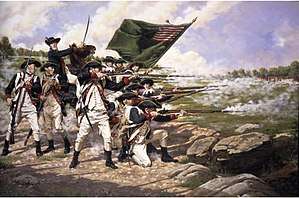
After regrouping at Halifax, William Howe determined to take the fight to the Americans.[138] He set sail in June 1776 and began landing troops on Staten Island near the entrance to New York Harbor on July 2. The Americans rejected Howe's informal attempt to negotiate peace.[139] When Washington split his army to positions on Manhattan Island and across the East River in western Long Island,[140] on August 27 at the Battle of Long Island Howe outflanked Washington and forced him back to Brooklyn Heights, but he did not attempt to encircle Washington's forces.[141]
Through the night of August 28, General Henry Knox bombarded the British. On August 29, an American council of war all agreed to retreat to Manhattan. Washington quickly had his troops assembled and ferried them across the East River to Manhattan on flat-bottomed freight boats without any losses in men or ordnance, with General Thomas Mifflin's regiments in the rear guard.[142][143]
The Staten Island Peace Conference failed to negotiate peace as the British delegates did not have authority to recognize independence to meet the rebel demands.[144][145] Howe seized control of New York City on September 15 and unsuccessfully engaged the Americans the following day.[146] He failed to encircle the Americans at the Battle of Pell's Point, then the Americans successfully withdrew. Howe declined to close with Washington's army on October 28 at the Battle of White Plains, but instead concentrated his efforts on a hill that was of no strategic value.[147][148]
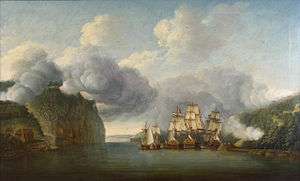
Washington's retreat had left his remaining forces isolated, and the British captured their Fort Washington on November 16. The British victory there took 3,000 prisoners and amounted to Washington's most disastrous defeat.[149] Washington's remaining army on Long Island fell back four days later.[150] Henry Clinton wanted to pursue Washington's disorganized army, but he was required to commit 6,000 troops to first capture Newport, Rhode Island in an operation that he had opposed.[151][152] The American prisoners were subsequently sent to the infamous prison ships where more American soldiers and sailors died of disease and neglect than died in every battle of the war combined.[153] Charles Cornwallis pursued Washington, but Howe ordered him to halt and Washington marched away unmolested.[154][155]
The outlook was bleak for the American cause; the reduced army had dwindled to fewer than 5,000 men and that number would be reduced further when enlistments expired at the end of the year.[156] Popular support wavered, morale ebbed away, and Congress abandoned Philadelphia.[157] Loyalist activity surged in the wake of the American defeat, especially in New York.[135]
News of the campaign was well received in Britain with festivities held in London, public support reached a peak,[158][159] and the King awarded the Order of the Bath to Howe. The successes led to predictions that the British could win within a year.[160] Strategic deficiencies among Patriot forces were evident by Washington's dividing a numerically weaker army in the face of a stronger one, inexperienced staff misreading the situation, and their troops fleeing in the face of enemy fire.[161] In the meantime, the British entered winter quarters and were in a good place to resume campaigning.[162]
On the night of December 25–26, 1776, Washington crossed the ice-choked Delaware River and surprised and overwhelmed the Hessian garrison at Trenton, New Jersey, and taking 900 prisoners.[163][lower-alpha 31] The decisive victory rescued the army's flagging morale and gave a new hope to the Patriot cause.[165] Cornwallis marched to retake Trenton, but his efforts were repulsed on January 2.[166][167] Washington outmaneuvered Cornwallis that night and defeated his rearguard the following day. The two victories contributed to convincing the French that the Americans were worthwhile allies.[168][169][170] Washington entered winter quarters at Morristown, New Jersey on January 6,[171] though a prolonged guerrilla conflict continued.[172] Howe made no attempt to attack, much to Washington's amazement.[173]
British northern strategy fails
In December 1776, John Burgoyne returned to London to set strategy with Lord George Germain. Burgoyne's plan was to isolate New England by establishing control of the Great Lakes from New York to Quebec. Efforts could then concentrate on the southern colonies, where it was believed that Loyalist support was widespread and substantial.[174]

Burgoyne's plan was to maneuver two armies by different routes and rendezvous at Albany, New York.[175] Burgoyne set out along Lake Champlain on June 14, 1777, quickly capturing Ticonderoga on July 5. From there the pace slowed. The Americans blocked roads, destroyed bridges, dammed streams, and stripped the area of food.[176] Meanwhile, Barry St. Ledger's diversionary column along the Mohawk River laid siege to Fort Stanwix. St. Ledger withdrew to Quebec on August 22 after his Indian support abandoned him. On August 16, a Brunswick foraging expedition was soundly defeated at Bennington, and more than 700 troops were captured.[177] The vast majority of Burgoyne's Indian support then abandoned him in the field, but Lord Howe informed him that he would still launch their planned campaign on Philadelphia, but without his support from New York.[178]
Burgoyne continued the advance, and he attempted to flank the American position at Freeman's Farm on September 19 in the First Battle of Saratoga. The British won, but at the cost of 600 casualties. Burgoyne then dug in, but he suffered a constant hemorrhage of deserters, and critical supplies ran low.[179] The Americans repulsed a British reconnaissance in force against the American lines on October 7, with heavy British losses during the second Battle of Saratoga. Burgoyne then withdrew in the face of American pursuit, but he was surrounded by October 13. With supplies exhausted and no hope of relief, Burgoyne surrendered his army on October 17, and the Americans took 6,222 soldiers as prisoners of war.[180]
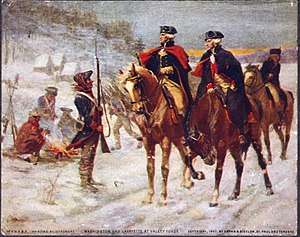
Meanwhile, Howe took command of a New York-based campaign campaign against Washington. Early feints failed to bring Washington to battle in June 1777.[181] Howe then declined to attack towards Philadelphia further, either overland via New Jersey or by sea via the Delaware Bay, leaving Burgoyne's initiative launched from the interior unsupported.
Later in the fall with additional supplies, Howe recommenced the Philadelphia campaign. This time on advancing, he outflanked and defeated Washington on September 11, but failed to pursue and destroy the defeated Americans on two occasions; once after the Battle of Brandywine,[182][183] and again after the Battle of Germantown.[182] A British victory at Willistown left Philadelphia defenseless, and Howe captured the city unopposed on September 26. He then moved 9,000 men to Germantown north of Philadelphia.[184] Washington launched a surprise attack there on Howe's garrison on October 4, but he was eventually repulsed.[185] Once again, Howe did not follow up on his victory.[186]
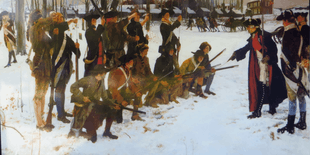
Howe, surprised by the American defenses, inexplicably ordered a retreat to Philadelphia after several days of probing at the Battle of White Marsh.[187] He ignored the vulnerable American rear, where an attack might possibly have deprived Washington of his baggage and supplies.[188] On December 19, Washington's army entered winter quarters at Valley Forge. Poor conditions and supply problems there resulted in the deaths of some 2,500 American troops.[189] During Washington's winter encampment at Valley Forge, Baron von Steuben, introduced the latest Prussian methods of drilling and infantry tactics to the entire Continental Army.[190]
While the Americans wintered only twenty miles away, Howe made no effort to attack their camp, which some critics argue could have ended the war.[191][192][193] Following the conclusion of the campaign, Howe resigned his commission, and was replaced by Henry Clinton on May 24, 1778.[194] Clinton received orders to abandon Philadelphia and fortify New York following France's entry into the war. On June 18, the British departed Philadelphia, with the reinvigorated Americans in pursuit.[195] The two armies fought at Monmouth Court House on June 28, with the Americans holding the field, greatly boosting Patriot morale and confidence.[196] By July, both armies were back in the same positions they had been two years prior.
Foreign intervention
Early in the war, it became clear to Congress that help from France was imperative. First, the British instituted a blockade on the Atlantic seacoast ports against military assistance that could not be challenged. Second, its army troop strength attrited by death, disease and desertion, and the states failed to meet recruitment quotas. Third, the British had a continuing resupply of German auxiliaries to compensate for their losses.[197]
French foreign minister the Comte de Vergennes was strongly anti-British,[198] and he had long sought a pretext for going to war with Britain since the conquest of Canada in 1763.[199] The French public favored war, but Vergennes and King Louis XVI were hesitant, owing to the military and financial risk.[200][201]
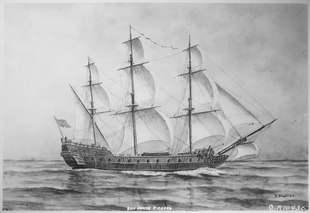
France, however, would not feel compelled to intervene if the colonies were still considering reconciliation with Britain, as France would have nothing to gain in that event.[197] To assure assistance from France, independence would have to be declared, which was effected by Congress in July 1776.[197] The Americans who had been covertly supplied by French merchants through neutral Dutch ports since the onset of the war, were now also supplied directly by the French government.[198] These proved invaluable in the American 1777 Saratoga campaign.[202][203][204]
The British defeat at Saratoga caused British anxiety over possible foreign intervention. The North ministry sought reconciliation with the colonies by consenting to their original demands, but without independence.[205] However the Americans were now bolstered by their French trade, and would settle for no terms short of complete independence from Britain.[206] The American victory at Saratoga convinced the French that supporting the Patriots was worthwhile,[201] but doing so too late brought major concerns. King Louis XVI feared that Britain's concessions would be accepted and bring reconciliation with the Colonies. Britain would then be free to strike at French Caribbean possessions.[207][208] To prevent this, France formally recognized the United States in a trade treaty on February 6, 1778, and followed that with a defensive military alliance guaranteeing American independence.[209][lower-alpha 32] Spain was wary of recognizing a republic of former European colonies, and also of provoking war with Britain before it was well prepared. It opted to covertly supply the Patriots mainly from Havana in Cuba and New Orleans in Spanish Louisiana.[211][212]
To encourage French participation in the American struggle for independence, diplomat Silas Deane promised promotions and command positions to any French officer who joined the American war effort. However, many of the French officer-adventurers were completely unfit for command. In one outstanding exception, Congress recognized Lafayette's "great zeal to the cause of liberty" and commissioned him a major General. He was immediately instrumental in reconciling some of Washington's rival officers and he aligned some of the delegates in Philadelphia to support Washington in an otherwise indifferent Congress.[213][214]
Congress also hoped to persuade Spain into an open alliance, as formally extended in the French treaty. The American Commissioners met with the Count of Aranda in 1776.[215] But Spain was still reluctant to make an early commitment due to its Great Power concerns on the Continent.[216] Nevertheless, the following year, Spain affirmed its desire to support the Americans so as to weaken Britain's empire.[217][218][lower-alpha 33]

Since the outbreak of the conflict, Britain had appealed to its former ally, the neutral Dutch Republic, to lend the use of the Scots Brigade for service in America. But pro-American sentiment there forced its elected representatives to deny the request.[220] Consequently, the British attempted to invoke treaties for outright Dutch military support, but the Republic still refused. At the same time, American troops were being supplied with ordnance by Dutch merchants via their West Indies colonies.[221] French supplies bound for America were also transshipped through Dutch ports.[198] The Republic traded with France following France's declaration of war on Britain, citing a prior concession by Britain on this issue. But despite standing international agreements, Britain responded by confiscating Dutch shipping, and even firing upon it. The Republic joined the First League of Armed Neutrality with Austria, Prussia and Russia to enforce their neutral status.[222] But The Republic had further assisted the rebelling Patriot cause. It had also given sanctuary to American privateers[223] and had drafted a treaty of commerce with the Americans. Britain argued that these actions contravened the Republic's neutral stance and declared war in December 1780.[224]
Meanwhile, George III had given up on subduing America while Britain had a European war to fight.[225] He did not welcome war with France, but he believed that Britain had made all necessary steps to avoid it and cited the British victories over France in the Seven Years' War as a reason to remain optimistic in the event of war with France.[226] Britain tried in vain to find a powerful ally to engage France. It was isolated among the Great Powers, and French strength was not drawn off into Europe as in the Seven Years' War.[227] Britain subsequently changed its focus from one theater,[228][229] and diverted major military resources away from America.[230][231] Despite these developments, George III still determined never to recognize American independence and to make war on the American colonies indefinitely, or until they pleaded to return as his subjects.[232][lower-alpha 34]
Stalemate in the North

with US Gen. Sullivan at the Battle of Rhode Island
Following the British defeat at Saratoga in October, 1777, and French entry into the war, Clinton withdrew from Philadelphia to consolidate his forces in New York.[231] French admiral the Comte d'Estaing had been dispatched to America in April 1778 to assist Washington. The Franco-American forces felt that New York's defenses were too formidable for the French fleet, so in August 1778 they launched an attack on Newport at the Battle of Rhode Island under the command of General John Sullivan.[234] The effort failed when the French opted to withdraw, disappointing the Americans.[235] The war then stalemated. Most actions were fought as large skirmishes such as those at Chestnut Neck and Little Egg Harbor. In the summer of 1779, the Americans captured British posts at the Battles of Stony Point and Paulus Hook.[236] In July, Clinton unsuccessfully attempted to coax Washington into a decisive engagement by making a major raid into Connecticut.[237] That month, a large American naval operation attempted to retake Maine, but it resulted in a humiliating defeat.[238] The high frequency of Iroquois raids compelled Washington to mount a punitive expedition which destroyed a large number of Iroquois settlements, but the effort ultimately failed to stop the raids.[239][240] During the winter of 1779–80, the Continental Army suffered greater hardships than at Valley Forge.[241] Morale was poor, public support fell away in the long war, the national currency was virtually worthless, the army was plagued with supply problems, desertion was common, and whole regiments mutinied over the conditions in early 1780.[242]

In 1780, Clinton launched an attempt to retake New Jersey. On June 7, 6,000 men invaded under Hessian general Wilhelm von Knyphausen, but they met stiff resistance from the local militia at the Battle of Connecticut Farms. The British held the field, but Knyphausen feared a general engagement with Washington's main army and withdrew.[243] A second attempt two weeks later was soundly defeated at Springfield, effectively ending British ambitions in New Jersey.[244] Meanwhile, American general Benedict Arnold turned traitor, joined the British army and attempted to surrender the American West Point fortress. The plot was foiled when British spy-master John André was captured. Arnold fled to British lines in New York where he justified his betrayal by appealing to Loyalist public opinion, but the Patriots strongly condemned him as a coward and turncoat.[245][246]
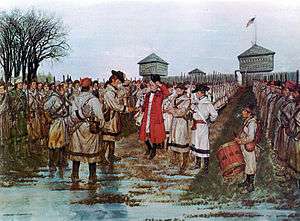
The war to the west of the Appalachians was largely confined to skirmishing and raids. In February 1778, an expedition of militia to destroy British military supplies in settlements along the Cuyahoga River was halted by adverse weather.[247][248] Later in the year, a second campaign was undertaken to seize the Illinois Country from the British. Virginia militia, francophone settlers and Indian allies commanded by Colonel George Rogers Clark captured Kaskaskia on July 4 and then secured Vincennes, although Vincennes was recaptured by Quebec Governor Henry Hamilton. In early 1779, the Americans counter-attacked and retook Vincennes, taking Hamilton prisoner.[249]
On May 25, 1780, the British launched an expedition into Kentucky as part of a wider operation to clear rebel resistance from Quebec to the Gulf coast. Hundreds were killed or captured, but the initiative met with only limited success.[250][lower-alpha 35] The Americans responded with a major offensive along the Mad River in August which met with some success, but it did little to abate the Indian raids on the frontier.[251] French militia attempted to capture Detroit, but it ended in disaster when Miami Indians ambushed and defeated the gathered troops on November 5.[252] The war in the west had become a stalemate; the Americans did not have the manpower to simultaneously defeat the hostile Indian tribes and occupy the land.[253]
War in the South
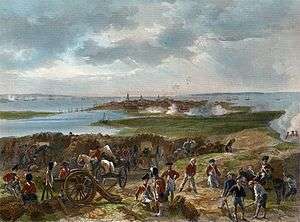
The British turned their attention to conquering the South in 1778 after Loyalists in London assured them of a strong Loyalist base there. Squadrons of the Royal Navy would be closer to the British Caribbean colonies to defend against attacking Franco-Spanish fleets.[254] On December 29, 1778, Lord Cornwallis commanded an expeditionary corps from New York to capture Savannah, and British troops then moved inland to recruit Loyalist support.[255]
The initial Loyalist recruitment was promising in early 1779, but then a large Loyalist-only militia was defeated by Patriot militia at Kettle Creek on February 14. That demonstrated Loyalist need for the support of British regulars in major engagements. But the British in turn defeated Patriot militia at Brier Creek on March 3.[256] In June they launched an abortive assault on Charleston, South Carolina. The operation became notorious for its widespread looting by British troops that enraged both Loyalists and Patriots in the Carolinas. In October, a combined Franco-American siege by Admiral d'Estaing and General Benjamin Lincoln failed to recapture Savannah.[257]
The primary British strategy for the following year hinged on a Loyalist uprising in the south. Cornwallis proceeded into North Carolina, gambling his success on a large Loyalist uprising which never materialized.[258] In May 1780, Henry Clinton captured Charleston, taking over 5,000 prisoners and effectively destroying the Continental Army in the south. Organized Patriot resistance in the region collapsed when Banastre Tarleton defeated the withdrawing Americans at Waxhaws on May 29.[259]
British commander-in-chief Clinton returned to New York, leaving General Lord Cornwallis at Charleston to oversee the southern war effort. Few Loyalists joined him there. The initiative was seized by Patriot militias who won July victories at the Fairfield County, Lincolnton, Huck's Defeat, Stanly County, and Lancaster County. These effectively suppressed Loyalist support.[260]
In July, Congress appointed General Horatio Gates with a new command to lead the American effort in the south. By mid-August 16, 1780, he had lost the Battle of Camden, and Cornwallis was poised to invade North Carolina.[261] The British attempted to subjugate the countryside, but Patriot militia continued their attacks. Cornwallis dispatched Major Patrick Ferguson to raise Loyalist forces to cover his left flank as he moved north, but they ranged beyond mutual support.[262] In early October the Tory regulars and militias were defeated at the Battle of Kings Mountain, destroying any significant Loyalist support in the region.[263] Cornwallis advanced into North Carolina despite the setbacks, gambling that he would receive substantial Loyalist support there. Greene evaded combat with Cornwallis, instead wearing the British down through a protracted war of attrition.[264]
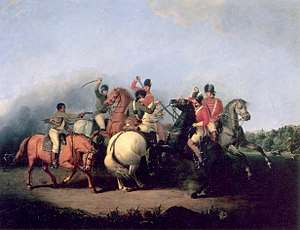
Battle of Cowpens, 1781
Washington replaced General Gates with General Nathanael Greene At the beginning of December 1780.[265] Greene was unable to confront the British directly, so he dispatched a force under Daniel Morgan to recruit additional troops. Morgan then defeated the renowned British Legion, on January 17, 1781, at Cowpens. Cornwallis subsequently aborted his advance and retreated back into South Carolina.[266]
The British launched a surprise offensive in Virginia in January 1781, with Benedict Arnold invading Richmond, Virginia. It met little resistance. Governor Thomas Jefferson escaped Richmond just ahead of the British forces, and the British burned the city to the ground.[267][268] Although later accused by his enemies of inaction and cowardice, Jefferson sent an emergency dispatch to nearby Colonel Sampson Mathews to check Arnold's advance.[269]
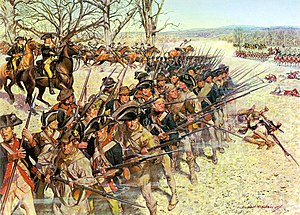
Battle of Guilford
By March, Greene's army had increased in size enough that he felt confident in facing Cornwallis who was far from his supply base. The two armies engaged near Guilford Courthouse on March 15. Accompanied by lieutenant colonel "Light Horse Harry"[lower-alpha 36] and his cavalry, the fighting went back and forth with the first British advance resulting in their retreat. The second clash occurred in a wooded area mostly involving close-quarters combat. During the chaotic melee Cornwallis has his horse shot out from under him, however, Greene was beaten, but Cornwallis's army suffered irreplaceable casualties.[271][272] The Americans further reduced his army in a war of attrition,[266] and far fewer Loyalists were joining than the British had previously expected.[273] Cornwallis's casualties were such that he was compelled to retreat to Wilmington for reinforcement, leaving the Patriots in control of the interior of the Carolinas and Georgia.[274]
Greene then proceeded to reclaim the South. On April 25 the American troops suffered a reversal at Hobkirk's Hill due to poor tactical control, but they continued to march 160 miles in 8 days, continually dislodging strategic British posts in the area nonetheless. They recaptured Fort Watson and Fort Motte on April 15.[275][274][276] During the Siege of Augusta on June 6, Brigadier general Andrew Pickens reclaimed possession of the last British outpost beyond Charleston and Savannah.[277]
The last British effort to stop Greene occurred at Eutaw Springs on September 8, but the British casualties were so high that they withdrew to Charleston.[278] By the end of 1781, the Americans had effectively confined the British to the Carolina coasts, undoing any progress they had made in the previous year.[278] Minor skirmishes continued there until the end of the war.[260]
Mississippi River theater
In America east of the Mississippi River, though Spanish Louisiana territory ran west of it, Governor General Gálvez had been allowing covert aid to George Washington by Pittsburgh via New Orleans. In 1777 Oliver Pollock, a successful merchant in Havana and New Orleans, was appointed US "commercial agent". He personally underwrote an American campaign against the British among the francophone settlements of western Quebec. In the Virginia militia campaign of 1778, General George Rogers Clark founded Louisville, and cleared British forts in the region.[279] Clark's conquest resulted in the creation of Illinois County, Virginia. It was organized with the consent of French-speaking colonials who had been guaranteed protection of the Catholic Church. Voters at their court house in Kaskaskia, were represented for three years in the Virginia General Assembly until the territory was ceded to the US Congress.[280]
Mississippi River Basin |
|
At the Spanish declaration of war with France in 1779, Governor Gálvez raised an army in Spanish Louisiana to initiate offensive operations against British outposts.[281] First, he cleared British garrisons in Baton Rouge, Fort Bute and Natchez, capturing five forts.[282] In this first maneuver Gálvez opened navigation on the Mississippi River north to US settlement in Pittsburg.[283] His Spanish military assistance to Oliver Pollock for transport up the Mississippi River became an alternative supply to Washington's Continental Army, bypassing the British-blockaded Atlantic Coast.[284] In 1781, Governor Galvez and Pollack campaigned east along the Gulf Coast to secure West Florida including British-held Mobile and Pensacola.[285] The Spanish operations crippled the British supply of armaments to British Indian allies, effectively suspending a military alliance to attack settlers between the Mississippi River and Appalachian Mountains.[286][lower-alpha 37]
In April 1782 at the Battle of the Saintes, the British parried the French-Spanish invasion of Jamaica, then dominated the Caribbean Sea. In February 1783 Spanish lifted their siege of Gibraltar. A Spanish-US fleet captured Bahamas was returned at the peace. The belligerents had all lost heart for continued warfare. After George III announced for US independence in a Speech before the Throne before a joint session of Parliament in December 1782, the British proffered terms to the Americans in Paris, which were then approved by Congress April 1783.[287] British "American settlement" allowed US fishing rights in Newfoundland and the Gulf of Mexico, along with "perpetual access" to the Mississippi River. The two British treaties with France and Spain settled their three-way swaps of imperial territory in September. The British settled their Fourth Anglo-Dutch War the next year.[288]
British defeat in America
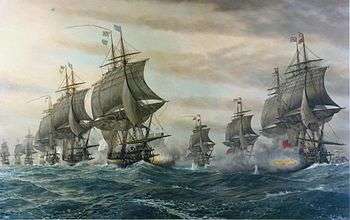
Battle of the Chesapeake, 1781
In 1781, the British commander-in-chief in America was General Clinton, who was garrisoned in New York City. He had failed to construct a coherent strategy for British operations that year, owing to his difficult relationship with his naval counterpart Admiral Marriot Arbuthnot. Arbuthnot in turn had failed to detect the arrival of French naval forces in July.[289] In Charleston, Cornwallis independently developed a plan for a campaign in Virginia to cut supply to Greene's army in the Carolinas, expecting the Patriot resistance in the South would then collapse. Lord Germain, Cabinet Secretary of State for America in London agreed, but neither official informed Clinton.[290][291]
Washington and the Comte de Rochambeau discussed their options. Washington pushed for an attack on New York, while Rochambeau preferred a strike in Virginia, where the British were less well-established and thus easier to defeat.[292] Franco-American movements around New York caused Clinton a great deal of anxiety, fearing an attack on the city. His instructions were vague to Cornwallis during this time, rarely forming explicit orders. However, Clinton did instruct Cornwallis to establish a fortified naval base and to transfer troops to the north to defend New York.[293]
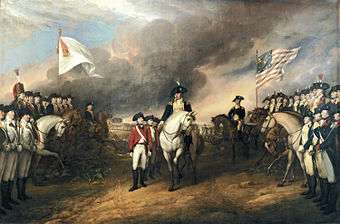
Cornwallis maneuvered to Yorktown to establish a fortified a sea-base of supply. But at the same time Lafayette was maneuvering south with a Franco-American army.[294][lower-alpha 38] The British dug in at Yorktown and awaited the Royal Navy.[300] As Lafayette's army closed with Cornwallis, the British made no early attempt to sally out to engage the Americans before siege lines could be dug, despite the repeated urging of his subordinate officers.[301] Expecting relief from Admiral Arbuthnot shortly to facilitate his withdrawal off the Virginia Peninsula, Cornwallis prematurely abandoned his outer defenses. These were promptly occupied by the besiegers, serving to hasten the British defeat.[302][lower-alpha 39]
The British had dispatched a fleet from New York under Thomas Graves to rendezvous with Cornwallis.[305] As they approached the entry to the Chesapeake Bay on September 5, the French fleet commanded by Admiral de Grasse decisively defeated Graves at the Battle of the Chesapeake, giving the French control of the seas around Yorktown and cutting off Cornwallis from further reinforcements or relief.[306] On the unexpected arrival of the French fleet, Cornwallis then failed in an attempt to break out of the siege by crossing the York River at Gloucester Point when a storm hit.[307] Cornwallis and his subordinates were under heavy bombardment and facing dwindling supplies, they agreed that their situation was untenable.[308][lower-alpha 40] On October 17, 1781, after twelve hours of negotiations, the terms of surrender were finalized.[309]
North Ministry collapses
Lord North had been the King's Prime Minister in Parliament since 1770. By the end of 1777 with the loss of the first British army, King George III had determined that in the event of his initiating a separate war with France, he would have to redeploy most of the British and German troops in America to threaten French and Spanish Caribbean settlements. In the King's judgment, Britain could not possibly fight on all three fronts without becoming weak everywhere. At the news of the French-US treaties for trade and defense arrived at London, British negotiators proposed a second peace settlement to Congress.[310]
|
The Carlisle Peace Commission was sent across the Atlantic to make a formal presentation to Congress. Firstly, virtual self-government by a kind of "home-rule" was contemplated. It would recognize Congress, suspend all objectionable acts of Parliament, surrender Parliament's the right to taxation, and perhaps allow American representatives to the House of Commons. But secondly, all property would be restored to loyal subjects, their debts honored, with locally enforced martial law, Parliament to regulate trade, and the Declaration of Independence withdrawn. Parliament's commission was rebuffed by a Congress which knew the British were about to evacuate Philadelphia. Before it returned to London in November 1778, the commission directed a change in British war policy. Sir Henry Clinton, the new British Commander-in-Chief in America was to stop treating rebels as subjects whose loyalty might be regained. Now they were to be enemies fought with ruthless hate.[311] Those standing orders would be in effect for three years until Clinton was relieved.[312]
Prior to the surrender of Cornwallis's army at Yorktown, George III still had hoped for victory in the South. He believed a majority of American colonists supported him, especially in the South and among thousands of black slaves. But after Valley Forge, the Continental Army was an efficient fighting force. After a two-week siege at Yorktown by Washington's army, a successful French fleet, French regulars and local reinforcements, the British surrendered on October 19, 1781. Lord North exclaimed, “Oh God! It is all over." Nevertheless, Lord North rebutted the Whig resolution in Commons to end offensive operations in America. The speech postponed the inevitable several weeks.[313]
But the mood of the country in Great Britain had changed since the 1770s. Member of Parliament Edward Gibbon had believed the King's cause in America to be just, and the British and German soldiers there fought bravely. But after Yorktown, he concluded, "It is better to be humbled than ruined." There was no point in spending more money on Britain's most expensive war, with no hope of success. Whig William Pitt argued that war on American colonists had brought nothing but ineffective victories or severe defeats. He condemned effort to retain the Americans as a "most accursed, wicked, barbarous, cruel, unjust and diabolical war."[311] Lord North resigned. George III never forgave him.[314]
From the time London learned of the surrender of a second British army, it was only two weeks before the Whig Opposition motion to end offensive war in America which was defeated by only one vote. Three days later, on December 15, George III made a Speech from the Throne to a joint session of Parliament announcing for American independence, peace and trade. Less than two months later on February 27, 1782, the Commons carried the motion by 19 votes.[315] At a vote of no confidence against Lord North, the Rockingham Whigs came to power and opened negotiations for peace with the Americans. Rockingham died and was succeeded by the Earl of Shelburne. The British troops remaining in America were garrisoned in the three port cities of New York, Charleston, and Savannah.[316] General Clinton was recalled and replaced by Guy Carleton who was ordered to suspend offensive operations.[312]
Analysis of combatants
United States

To win the American Revolution, the United States had to outlast the will of the British Crown and its government in Parliament to subdue them. For the British to win the conflict, they had to defeat the Continental Army early in the war and force the dissolution of Congress.[317] Congress had multiple advantages if the rebellion turned into a protracted war. Their prosperous state populations depended on local production for food and supplies rather than on imports from a Mother Country that lay six to twelve weeks away by sail. They were spread across most of the North American Atlantic seaboard stretching 1000 miles. Most farms were remote from the seaports; control of four or five major ports did not give British armies control over the inland areas. Each state had established internal distribution systems.[318]
Each colony had a long-established system of local militia, combat tested in support of British regulars thirteen years before to secure an expanded British Empire. Together they took away French claims in North America west to the Mississippi River. The state legislatures independently funded and controlled their local militias. They would train and provide Continental Line regiments to the regular army, each with their own state officer corps.[318] Motivation was also a major asset. Each colonial capital had its own newspapers and printers. The Patriots had more popular support than the Loyalists. British hoped for the Loyalists to do much of the fighting, but they did much less than expected.[6]
Continental Army

Commander of the Continental Army
When the war began, Congress lacked a professional army or navy, and each colony maintained only local militias. Militiamen were lightly armed, had little training, and usually without uniforms. Their units served for only a few weeks or months at a time and lacked the training and discipline of soldiers with more experience. Local county militias were reluctant to travel far from home and they were unavailable for extended operations. However, if properly employed their numbers could help the Continental armies overwhelm smaller British forces, as at Concord, Boston, Bennington, and Saratoga. Both sides used partisan warfare, but the state militias effectively suppressed Loyalist activity when British regulars were not in the area.[319] The Congress established a regular army on June 14, 1775, and appointed George Washington as commander-in-chief. The development of the Continental Army was always a work in progress, and Washington used both his regulars and state militia throughout the war.[lower-alpha 41]
Though Congress had responsibility for the war effort and getting supplies to the troops, Washington took it upon himself to pressure the Congress and state legislatures to provide the essentials. There was never nearly enough.[322] Congress evolved in its committee oversight, establishing the Board of War which included members of the military.[58][323] But the Board of War was also a committee ensnared with its own internal procedures, so Congress created the post of Secretary of War, appointing Major General Benjamin Lincoln in February, 1781. Washington worked closely with Lincoln in coordinating civilian and military authorities[58] and took charge of training and supplying the army.[59]
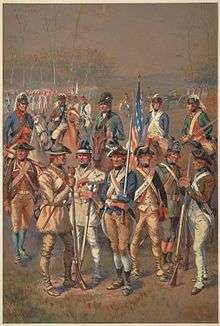
Continental Army uniforms
The new Continental Army suffered significantly from a lack of an effective training program and from largely inexperienced officers and sergeants. The inexperience of its officers was somewhat offset by a few senior officers.[59] Each state legislature appointed officers for both county and state militias and their regimental Continental Line officers, but Washington was permitted to choose and command his own generals, although sometimes he was required to accept Congressional appointments.[324]
Eventually, the Continental Army found capable officers such as Nathanael Greene, Daniel Morgan, Henry Knox (chief of artillery), and Alexander Hamilton (chief of staff).[325] One of Washington's most successful recruits to general officer was Baron Friedrich Wilhelm von Steuben, a veteran of the Prussian general staff who wrote the Revolutionary War Drill Manual.[59] Over the winter of 1777–78 at Valley Forge, von Steuben was instrumental in training the Continental Army in the essentials of infantry field maneuvers with military discipline, drills, tactics, and strategy.[59]
The American armies were small by European standards of the era, largely attributable, to limitations such as lack of powder and other logistics.[lower-alpha 42][lower-alpha 43] At the beginning of 1776, Washington commanded 20,000 men, with two-thirds enlisted in the Continental Army and the other third in the various state militias. About 250,000 men served as regulars or as militiamen for the Revolutionary cause in the eight years of the war, but there were never more than 90,000 men under arms at one time.[328]
Over the entire course of the war, American officers as a whole never equaled their opponents in tactics and maneuver, and they lost most of the pitched battles. The great successes at Boston (1776), Saratoga (1777), and Yorktown (1781) came from trapping the British far from base with much larger numbers of troops.[329] Nevertheless, after 1778, Washington's army was transformed into a more disciplined and effective force.[59] Immediately after the Army emerged from Valley Forge, it proved its ability to match the British troops in action at the Battle of Monmouth, including a black Rhode Island regiment fending off a British bayonet attack then counter-charging for the first time in Washington's army.[330]
Continental Navy

During the first summer of the war, Washington began outfitting schooners and other small sea-going vessels to prey on ships supplying the British in Boston.[331]
.jpg)
Congress established the Continental Navy on October 13, 1775, and appointed Esek Hopkins as the Navy's first commander.[332] The following month, Marines were organized on November 10, 1775.[333] The Continental Navy was a handful of small frigates and sloops throughout the Revolution for the most part.
John Paul Jones became the first great American naval hero, capturing HMS Drake on April 24, 1778, the first victory for any American military vessel in British waters.[334] The last was by the frigate USS Alliance commanded by Captain John Barry. On March 10, 1783, the Alliance outgunned HMS Sybil in a 45-minute duel while escorting Spanish gold from Havana to Congress.[335] After Yorktown, all US Navy ships were sold or given away. For the first time in America's history she had no fighting forces on the high seas.[336]
Congress primarily commissioned privateers as a cost savings, and to take advantage of the large proportion of colonial sailors found in the British Empire. Overall, they included 1,700 ships, and these successfully captured 2,283 enemy ships to damage the British effort and to enrich themselves with the proceeds from the sale of cargo and the ship itself.[337] In what was known as the Whaleboat War, American privateers mainly from New Jersey, Brooklyn and Connecticut attacked and robbed British merchant ships and raided and robbed coastal communities of Long Island reputed to have Loyalist sympathies.[338][339][340] About 55,000 sailors served aboard American privateers during the war.[8]
Logistics
Generally throughout the Revolution, inadequate provisioning of the Continental Army led to serious difficulty in maintaining a force in the field. From July 1779 to July 1780, the Army shrunk from twenty-six thousand men to less than fifteen thousand. Only the most committed of revolutionaries persisted throughout the conflict, although some numbers reentered service after leaving at end-of-enlistment, desertion, or mutiny amnesty. Several factors contributed: lack of food regularly distributed in ration quantity, inadequate or no pay, and in 1780-81 the harshest winter of the war.[341]
Overall, the problem was fundamentally a financial one. The Continental currency depreciated, inflation accelerated.[342] The British government maintained a financial campaign counterfeiting a flood of paper currency in Continental dollars to sabotage the war effort.[343] Continental currency became worthless, state treasuries were empty, towns went bankrupt, and the marketplace was paralyzed by Quartermaster and Commissary certificates[344].[lower-alpha 44] Both Congress and states shared in the failure of the “specific supplies” system that Congress undertook by committee. From the standpoint of legislation, states did not tell Congressional Boards nor their delegates in Congress what they had, and Congress requisitioned the states for food in resolves that were only published in Philadelphia newspapers. Congressional requisitions to each state were proportionately based on wealth and population, but those formulas did not match the ability to respond in each state.[345][lower-alpha 45]
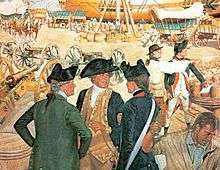
Even during the emergency of war with national survival at issue, American colonial traditions of local self-government thwarted efforts to supply a national "standing army".[lower-alpha 46] States interfered with shipments of army provisions, Continental Army and Navy supply officials were drafted into state militias, and local magistrates would not enforce impressment when farmers withheld food from the military for speculators.[346] States either could not or refused to cooperate with Congress, civilians everywhere resisted and then refused to participate in markets to supply and provision the army. When Continental, state or local officials were given authority to impress goods for army use without compensation, it was either actively resisted or only half-heartedly attempted.[347] State provincialism also played a part.[348][lower-alpha 47]
As a matter of administration and logistics, the most serious aspect limiting military supply was the immense difficulty in acquiring provisions and transportation. Middlemen and speculators bought up food before it reached market, adding their margins to state expense. French regiments in Maryland and Connecticut paid in gold and silver, preempting state purchase of army requisitions in Continental dollars or worse, by certificates.[349] Even when states gathered supply, there was no administrative means provided to take it to the Continental Army. Unaccessed food rotted in state depositories.[350] The most serious related event was the mutiny of the Continental Pennsylvania Line in January 1781, followed by that of the New Jersey Line later the same month. The two mutinies followed one years' service without pay of any kind, along with a sporadic supply of inadequate food and clothing.[351]
Congressional delegates feared for the future of their revolution and the nation's independence. Among the correspondents of George Washington pleading in his daily correspondence for Continental Army support, a Nationalist movement developed within every state. State commissioners met in a Hartford Convention from 11 to 22 November 1780, recommending an end to the administrative Boards of mixed Congressional and civilian advisors. Nationalist majorities in state legislatures increased their Congressional delegations with numbers of former Continental Army officers.[352][lower-alpha 48] The Nationalist caucus in Congress replaced the Boards with independent executive Secretaries of Foreign Affairs, Finance, War, and Marine (Oceans). Unfortunately these were likewise mostly secretarial posts accumulating reports to submit to Congress for action. [353]
Late in the war, Congress hoped that shifting direct responsibility onto the state legislatures for each state militia Line regiment in Continental service would result in better provisioning. It asked individual state legislatures to equip their own troops and pay upkeep for their own citizen soldiers in the Continental Army. When the war ended, the United States had spent $37 million at the national level and $114 million at the state level. The United States finally solved its debt problems in the 1790s when Congress assumed all state war debt to attach the states to the new Constitution's central government, and it founded the First Bank of the United States to establish the good faith and credit of the United States.[354]
Intelligence and espionage
At the onset of the war, the Second Continental Congress realized that they would need foreign alliances and intelligence-gathering capability to defeat a world power like Britain. To this end, they formed the Committee of Secret Correspondence which operated from 1775 to 1776 for "the sole purpose of corresponding with our friends in Great Britain and other parts of the world". Through secret correspondence the Committee shared information and forged alliances with persons in France, England and throughout America. It employed secret agents in Europe to gather foreign intelligence, conduct undercover operations, analyze foreign publications, and initiate American propaganda campaigns to gain Patriot support.[355] Members included Thomas Paine, the committee's secretary, and Silas Deane who was instrumental in securing French aid in Paris.[356][lower-alpha 49]
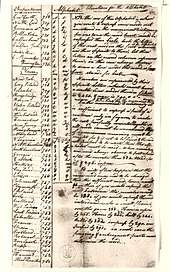
Facing off against the British at New York City, Washington realized that he needed advance information to deal with disciplined British regular troops. On August 12, 1776, Thomas Knowlton was given orders to form an elite group for reconnaissance and secret missions. Knowlton's Rangers became the Army's first intelligence unit.[358] Among the Rangers was Nathan Hale.[355][359] When the British landed on Long Island with overwhelming force, Washington's army narrowly escaped and retreated across the East River in dozens of small riverboats to New York City on Manhattan Island.[lower-alpha 50] Washington directed volunteer Hale to spy on enemy activity behind their lines in Brooklyn. After the British attack on September 15, Hale was captured and with sketches of British fortifications and troop positions. Howe ordered Hale summarily hung without trial the next day (September 22).[360]
Once Washington was driven out of New York, he realized that he would need more than military might and amateur spies to defeat the British and earnestly made efforts to professionalize military intelligence with the aid of Benjamin Tallmadge. They created the Culper spy ring of six men.[lower-alpha 51] Washington promised members of the ring that their identities and activities would never be revealed.[lower-alpha 52] All name references had a number code, and the spies used vanishing ink for their messages.[363] Among the more notable achievements of the ring was exposing Benedict Arnold's treasonous plans to capture West Point, along with his collaborator John André, Britain's head spymaster,[364][365][lower-alpha 53] and later they intercepted and deciphered coded messages between Cornwallis and Clinton during the Siege of Yorktown, leading to Cornwallis's surrender.[367][368] By 1781, the amateur shortcomings of British intelligence had been corrected, enabling Clinton and Cornwallis to predict patriot movements and capabilities. However, the improvements came too late to reverse British misfortunes.[369] During the war, Washington spent more than 10 percent of military funds on intelligence operations.[355] Some historians maintain that, without the efforts of Washington and the Culper Spy Ring, the British would never have been defeated.[362][361]
Great Britain
The population of Great Britain and Ireland in 1780 was approximately 12.6 million,[370] while the Thirteen Colonies held a population of some 2.8 million, including some 500,000 slaves.[371] Theoretically, Britain had the advantage; however, many factors inhibited raising a large army for a war that was unpopular at home.
Suppressing a rebellion in America presented the British with major problems. The key issue was distance; it could take up to three months to cross the Atlantic, and orders from London were often outdated by the time that they arrived.[372][373]The colonies had never been formally united prior to the conflict and there was no centralized area of ultimate strategic importance. Traditionally, the fall of a capital city often signaled the end of a conflict,[374] yet the war continued unabated even after the fall of major settlements such as New York, Philadelphia (where Congress met), and Charleston.[375] Britain's ability to project its power overseas lay chiefly in the power of the Royal Navy, allowing her to control major coastal settlements with relative ease and to enforce a strong blockade of colonial ports. However, the overwhelming majority of the American population was agrarian, not urban, and the American economy proved resilient enough to withstand the blockade's effects.[376]
The vastness of the American countryside and the limited manpower available meant that the British could never simultaneously defeat the Americans and occupy captured territory. One British statesman described the attempt as "like trying to conquer a map".[377]
British forces
In 1775, the standing British Army, exclusive of militia, comprised 45,123 men worldwide, made up of 38,254 infantry and 6,869 cavalry. Their Army had approximately eighteen regiments of foot, some 8,500 men, stationed in North America.[378][lower-alpha 54]
The British army at home had been deliberately kept small in peacetime to prevent abuses of power by the King.[118][lower-alpha 55] Despite this, eighteenth century armies were not welcome guests among British civilian populations, and were regarded with scorn and contempt by the press and public of the New and Old World alike, derided as enemies of liberty.[380] The idle peacetime Army fell into corruption and inefficiency, resulting in many administrative difficulties once campaigning began.[381]
By the end of hostilities in America at the close of 1781, the British Army numbered approximately 121,000 men globally,[13] 48,000 of whom were stationed throughout the Americas.[12] Of the 171,000 sailors[16] who served in the Royal Navy throughout the conflict, around a quarter were pressed. This same proportion, approximately 42,000 men, deserted during the conflict.[16] At its height, the Navy had 94 ships-of-the-line,[11] 104 frigates[15] and 37 sloops[15] in service.
Commanders-in-chief
Britain had three commanders-in-chief from initial days to final conclusion. First was General Sir William Howe, commanding British forces in North America 1775-1778 following the Battle of Bunker Hill, but still during the London policy of "soft war", trying to reconcile the American colonists to pre-1776 King-in-Parliament rule. At the loss of an army at Saratoga and France initiating war with Britain, Congress rejected the peace offer at the Carlisle Commission, and Howe's replacement as British commander-in-chief in 1778 was General Sir Henry Clinton for the duration of the fighting. London changed its war policy with orders to ruthlessly pursue victory against the colonists as enemies. Clinton's tenure ended at the loss of a second British army at Yorktown, and he was replaced by Sir Guy Carlton in early 1782 after the British-American armistice. Carlton then successfully managed the British evacuation of American port cities in Savannah, Charleston and New York City.

Howe made several strategic errors that cost the British opportunities for a complete victory early on. After securing control of New York, Howe dispatched Henry Clinton to capture Newport against Clinton's judgement that his command could have been put to better use pursuing Washington's retreating army.[382][152] Despite the bleak outlook for the revolutionary cause[383] and the surge of Loyalist activity in the wake of Washington's defeats,[135] Howe made no attempt to mount an attack upon Washington while the Americans settled down into winter quarters, much to their surprise.[173]
During his planning for the Saratoga campaign, Howe was to choose between committing his army to support Burgoyne, or capturing Philadelphia, the rebel capital. Howe decided upon the latter, determining that Washington was of a greater threat. When Howe launched his campaign, he approached Philadelphia round-about through the Chesapeake Bay, rather than directly overland through New Jersey, or by sea through the nearby Delaware Bay. The passage via the Virginia Capes left him unable to assist Burgoyne even if it was required of him. That decision so angered Tories on both sides of the Atlantic, that Howe was accused in Parliament of treason.[384]
At the Battle of White Marsh, Howe failed to exploit the vulnerable American rear,[188] and then he inexplicably ordered a retreat to Philadelphia after only minor skirmishes. His withdrawal astonished both sides.[187] However, there were strategic factors at play which compromised any aggressive action. Howe may have been dissuaded from direct assaults by the memory of the grievous losses the British suffered at Bunker Hill.[385][386] During the major campaigns in New York and Philadelphia, Howe often wrote of the scarcity of adequate provisions available by local foraging, which hampered his ability to mount effective campaigns.[387] Howe's tardiness in launching the New York campaign awaiting supplies, and his reluctance to allow Cornwallis to vigorously pursue Washington's beaten army, have both been attributed food shortages.[388][389]
During the winter of 1776–1777, Howe split his army into scattered cantonments. This decision dangerously exposed the individual forces to defeat in detail, as the distance between them was such that they could not mutually support each other.[390] But the quantity of available food supplies in New York City warehouses was so low that Howe had been compelled to take such a decision. The garrisons were widely spaced so their respective foraging parties would not interfere with each other's efforts.[391] This strategic failure allowed the Americans to achieve victory at the Battle of Trenton, and the concurrent Battle of Princeton.[392] Howe's difficulties during the Philadelphia campaign were also greatly exacerbated by the poor quality and quantity of resupply directly from Britain.[393]

Like Howe before him, Clinton's efforts to campaign suffered from chronic supply issues. In 1778, Clinton wrote to Germain complaining of the lack of supplies, even after the arrival of a convoy from Ireland.[394] That winter, the supply issue had deteriorated so badly, that Clinton expressed considerable anxiety over how the troops were going to be properly fed.[395] Clinton was largely inactive in the North throughout 1779, launching few major campaigns. This inactivity was partially due to the shortage of food.[396] By 1780, the situation had not improved. Clinton wrote a frustrated correspondence to Germain, voicing concern that a "fatal consequence will ensue" if matters did not improve. By October that year, Clinton again wrote to Germain, angered that the troops in New York had not received "an ounce" of that year's allotted stores from Britain.[397]
To emphasize his disappointment, Clinton had asked London that Admiral Mariot Arbuthnot be recalled.[289] Arbuthnot's relief was meant to be Admiral Sir George Rodney from the Leeward Islands command in late 1780, but Arbuthnot appealed to the admiralty. The replacement was upheld and Rodney took command in New York, but not before Arbuthnot narrowly turned back a French navy attempt in March 1781 to reinforce Lafayette in Virginia at the Battle of Cape Henry.[398][lower-alpha 56]
Anticipating the 1781 campaign year, General Lord Cornwallis with the British army Southern command in Charleston had written to both to Clinton, his Commander-in-Chief for America, and to War Minister Lord Germain in London. Cornwallis proposed an invasion into Virginia from Charleston to force a collapse of Patriot support throughout the South. Clinton objected, either counter-proposing that Cornwallis send reinforcements to New York City,[399] or favoring a campaign farther north in the Chesapeake Bay region.[400] Lord Germain wrote to Cornwallis to approve the General's plan, but Germain neglected to include Clinton in the decision-making, even though Clinton was Cornwallis's superior officer,[401]
Cornwallis then decided to move into Virginia without informing Clinton.[400][lower-alpha 57] Once learning that Cornwallis had chosen Yorktown as a fortified forward base, Clinton delayed sending reinforcements, because his intelligence led him to believe that the bulk of Washington's army was still outside New York City. Admiral Romney was sent with a fleet to cover Cornwallis redeployment to Yorktown, but the British were turned away by a French fleet at the Battle of the Chesapeake on September 5. Washington was eager to meet with de Grasse and agreed to meet at Lynnhaven Bay by way of the James River on a small vessel furnished by de Grasse. French resupply of the besieging Washington and Rochambeau was landed successfully.[402] Although scheduled to depart with a relief force for New York on October 5, Clinton was delayed. It was not until two weeks later on the day of surrender that 6,000 troops under Clinton departed New York sailing to relieve Yorktown on October 19, 1781.[403]
Logistics

and Brown Bess musket, 1767
Logistical organization of eighteenth century armies was chaotic at best, and the British Army was no exception. No logistical corps existed in the modern sense; while on campaign in foreign territories such as America, horses, wagons, and drivers were frequently requisitioned from the locals, often by impressment or by hire.[404] No centrally organized medical corps existed. It was common for surgeons to have no formal medical education, and no diploma or entry examination was required. Nurses sometimes were apprentices to surgeons, but many were drafted from the women who followed the army.[405] Army surgeons and doctors were poorly paid and were regarded as social inferiors to other officers.[406]
The heavy personal equipment and wool uniform of the regular infantrymen were wholly unsuitable for combat in America, and the outfit was especially ill-suited to comfort and agile movement.[407] During the Battle of Monmouth in late June 1778, the temperature exceeded 100 °F (38 °C), and heat stroke claimed more lives than actual combat.[408] The standard-issue firearm of the British Army was the Land Pattern Musket. Some officers preferred their troops to fire careful, measured shots (around two per minute), rather than rapid firing. A bayonet made firing difficult, as its cumbersome shape hampered ramming down the charge into the barrel.[409] British troops had a tendency to fire impetuously, resulting in inaccurate fire, a trait for which John Burgoyne criticized them during the Saratoga campaign. Burgoyne instead encouraged bayonet charges to break up enemy formations, which was a preferred tactic in most European armies at the time.[410]

Every battalion in America had organized its own rifle company by the end of the war, although rifles were not formally issued to the army until the Baker Rifle in 1801.[411] Flintlocks were heavily dependent on the weather; high winds could blow the gunpowder from the flash pan,[412] while heavy rain could soak the paper cartridge, ruining the powder and rendering the musket unable to fire. Furthermore, flints used in British muskets were of notoriously poor quality; they could only be fired around six times before requiring resharpening, while American flints could fire sixty. This led to a common expression among the British: "Yankee flint was as good as a glass of grog".[413]
Provisioning troops and sailors proved to be an immense challenge, as the majority of food stores had to be shipped overseas from Britain.[414] The need to maintain Loyalist support prevented the Army from living off the land.[415] Other factors also impeded this option; the countryside was too sparsely populated and the inhabitants were largely hostile or indifferent, the network of roads and bridges was poorly developed, and the area which the British controlled was so limited that foraging parties were frequently in danger of being ambushed.[416] After France entered the war, the threat of the French navy increased the difficulty of transporting supplies to America. Food supplies were frequently in bad condition. The climate was also against the British in the southern colonies and the Caribbean, where the intense summer heat caused food supplies to sour and spoil.[417] restore citation accidentely removed Life at sea was little better. Sailors and passengers were issued a daily food ration, largely consisting of hardtack and beer. The hardtack was often infested by weevils and was so tough that it earned the nicknames "molar breakers" and "worm castles",[419] and it sometimes had to be broken up with cannon shot. Meat supplies often spoiled on long voyages.[420] The lack of fresh fruit and vegetables gave rise to scurvy, one of the biggest killers at sea.[421]
Recruitment, discipline and officers
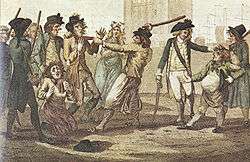
from a British caricature of 1780
Parliament suffered chronic difficulties in obtaining sufficient manpower,[422] and found it impossible to fill the quotas they had set.[423] The Army was a deeply unpopular profession, one contentious issue being pay.[lower-alpha 58] The rate of pay in the army was insufficient to meet the rising costs of living, turning off potential recruits,[426] as service was nominally for life.[427]
To entice voluntary enrollment, Parliament offered a bounty of £1.10s for every recruit.[428] As the war dragged on, Parliament became desperate for manpower; criminals were offered military service to escape legal penalties, and deserters were pardoned if they re-joined their units.[429][lower-alpha 59]
Impressment, essentially conscription by the "press gang", was a favored recruiting method, though it was unpopular with the public, leading many to enlist in local militias to avoid regular service.[432] Attempts were made to draft such levies, much to the chagrin of the militia commanders.[433] Competition between naval and army press gangs, and even between rival ships or regiments, frequently resulted in brawls between the gangs in order to secure recruits for their unit.[434] Men would maim themselves to avoid the press gangs,[435] while many deserted at the first opportunity.[436] Pressed men were militarily unreliable; regiments with large numbers of such men were deployed to remote garrisons such as Gibraltar or the West Indies, to make it harder to desert.[437]
.jpg)
Discipline was harsh in the armed forces, and the lash was used to punish even trivial offences—and not used sparingly.[438] For instance, two redcoats received 1,000 lashes each for robbery during the Saratoga campaign,[439] while another received 800 lashes for striking a superior officer.[440] Flogging was a common punishment in the Royal Navy and came to be associated with the stereotypical hardiness of sailors.[441]
Despite the harsh discipline, a distinct lack of self-discipline pervaded all ranks of the British forces. Soldiers had an intense passion for gambling, reaching such excesses that troops would often wager their own uniforms.[405] Many drank heavily, and this was not exclusive to the lower ranks.[442] Some reports indicated that British troops were generally scrupulous in their treatment of non-combatants.[443]
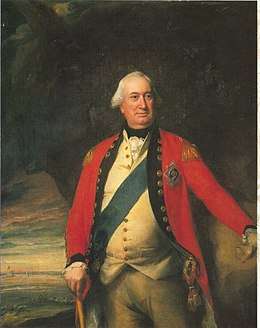
Britain had a difficult time appointing a determined senior military leadership in America. Thomas Gage, Commander-in-Chief of North America at the outbreak of the war, was criticized for being too lenient on the rebellious colonists. Jeffrey Amherst was appointed Commander-in-Chief of the Forces in 1778, but he refused a direct command in America because he was unwilling to take sides in the war.[444] Admiral Augustus Keppel similarly opposed a command: "I cannot draw the sword in such a cause". The Earl of Effingham resigned his commission when his regiment was posted to America, while William Howe and John Burgoyne were opposed to military solutions to the crisis. Howe and Henry Clinton both stated that they were unwilling participants and were only following orders.[445]
Officers in British service could purchase commissions to ascend the ranks,[446] and the practice was common in the Army.[447] Values of commissions varied but were usually in line with social and military prestige; for example, regiments such as the Guards commanded the highest prices.[448][lower-alpha 60] Wealthy individuals lacking any formal military education or practical experience often found their way into positions of high responsibility, diluting the effectiveness of a regiment.[450][lower-alpha 61]
Heavy drinking among senior British officers is well documented. William Howe was said to have seen many "crapulous mornings" while campaigning in New York. John Burgoyne drank heavily on a nightly basis towards the end of the Saratoga campaign. The two generals were also reported to have found solace with the wives of subordinate officers to ease the stressful burdens of command.[452] During the Philadelphia campaign, British officers deeply offended local Quakers by entertaining their mistresses in the houses where they had been quartered.[453]
Hessians
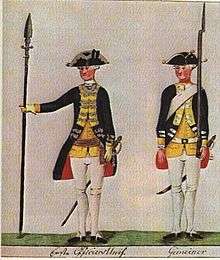
In 1775, without sufficient popular support at home to supply enlistments for the British Army overseas, London had to look elsewhere to find the number of troops required put down an expanding revolt in the Thirteen Colonies. Britain unsuccessfully attempted to secure 20,000 mercenaries from Russia,[454] and then it was denied use of the Scots Brigade from the Dutch Republic.[455] Parliament finally managed to negotiate treaties of subsidy with certain mercenary German princes in exchange for auxiliary troops to serve in America.[18] In total, 29,875 troops were hired for British service from six German states.[18][lower-alpha 62]
The presence of foreign soldiers speaking German-only caused considerable anxiety among the colonists, both Patriot and Loyalist. Newspaper accounts viewed them as brutal mercenaries.[457] It was also true that diaries of Hessian soldiers voiced objections to occasionally bad treatment of colonists at the hands of the British Army. Some officers had ordered property destruction and prisoner execution.[458]
British soldiers were themselves often contemptuous in their treatment of Hessian troops, despite orders from General Howe that "the English should treat the Germans as brothers". The order only began to have any real effect when the Hessians learned to speak a minimal degree of English, which was seen as a prerequisite for the British troops to accord them any respect.[459]
Loyalists
Wealthy Loyalists wielded great influence in London[460] and they were successful in convincing the British government that the majority view in the colonies was sympathetic toward the Crown. Consequently, British military planners pinned the success of their strategies on popular uprisings of Loyalists that never materialized.[lower-alpha 63]
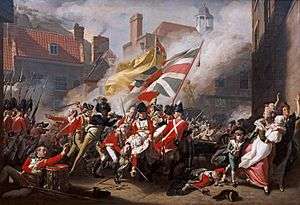
Recruiting adequate numbers of Loyalist militia to support British military plans in America was made difficult by intensive local Patriot opposition nearly everywhere.2001[lower-alpha 64] To bolster Loyalist militia numbers in the South, the British promised freedom and grants of land to slaves who fought for them.[463] Approximately 25,000 Loyalists fought for the British throughout the war.[17]
From early on, the British were faced with a major dilemma. Any significant level of organized Loyalist activity required a continued presence of British regulars.2001 The available manpower that the British commands had in America was insufficient to protect Loyalist territory while at the same time countering American offensives.2001 The Loyalist militias in the South were vulnerable to strings of defeats by their Patriot militia neighbors. The most critical combat between the two partisan militias was at Kings Mountain. The Patriot victory there irreversibly crippled any further Loyalist militia capability in the South.[266]
During the early war policy administered by General Lord Howe, the need to maintain Loyalist support prevented the British from using the harsh methods of suppressing revolts that they had used in Scotland and Ireland.2001 The Crown's cause suffered when British troops looted and pillaged the locals during an aborted attack on Charleston in 1779, enraging both Patriots and Loyalists.[257] After Congress rejected the Carlisle Commission settlement offer in 1778 and London turning to "hard war" during General Lord Clinton's command, neutral colonists in the Carolinas were often driven into the ranks of the Patriots whenever brutal combat broke out between Tories and Whigs.[464] Conversely, Loyalists were often emboldened when Patriots resorted to intimidating suspected Tories by destroying property or tarring and feathering.[465][466]
One outstanding Loyalist militia unit provided some of the best troops in the British service.[467] Their British Legion was a mixed regiment of 250 dragoons and 200 infantry, supported by batteries of flying artillery[468][lower-alpha 65] Under the command of Banastre Tarleton in the South, it gained a fearsome reputation in the colonies for "brutality and needless slaughter".[469] Nevertheless, in May 1779 the Loyalist British Legion was one of five regiments taken into British Army regular service as the American Establishment.[470] After the Battle of Cowpens in January 1781, British Legion survivors amounting to 14 percent of those engaged were consolidated into the British garrison at Charleston.[471]
British America and Empire
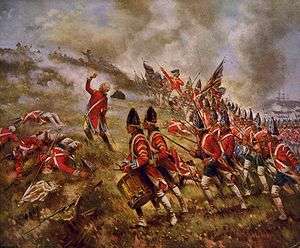
Battle of Bunker Hill, 1775.
Through 1775, the British leadership discovered it had overestimated the capabilities of its own troops, while underestimating those of the colonists. Strategic and tactical reassessments began in London and British America.[115][116] The immediate replacement of General Gage with General Howe followed the large casualties suffered in a frontal assault against shallow entrenchments at Bunker Hill.[472] Both British military and civil officials soon acknowledged that their initial responses to the rebellion had allowed the initiative to shift to the Patriots, as British authorities rapidly lost control over every colony.[117][lower-alpha 66]
As a part of the Anglo-French Second Hundred Years' War, beginning 1778–9, France and Spain again declared war on Britain. The British were forced to severely limit the number of troops and warships that they sent to America in order to defend the British homeland and key overseas territories.[230][231] The immediate strategic focus of the three greatest European colonial powers, Britain, France, and Spain, all shifted to Jamaica.[477] King George abandoned any hope of subduing America militarily while simultaneously contending with two European Great Powers alone.[478][lower-alpha 67]
The small size of Britain's army left them unable to concentrate their resources primarily in one theater of war with a Great Power ally as they had done before in the Seven Years' War allied with Prussia. That left them at a critical disadvantage.[228] London was compelled to disperse troops from America to Europe and the East Indies. These forces were unable to mutually support one other, exposing them to potential defeat everywhere.[233]
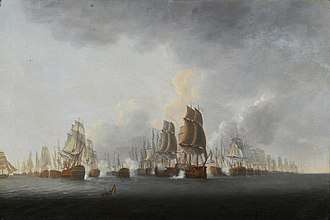
Nevertheless, the British secured a preliminary peace settlement in America, and it was agreed to in Congress April 1783. British military successes worldwide from 1782 to 1784 led to their ability to dictate their Treaty of Versailles (1783) with France, their Treaty of Versailles (1783) with Spain, and their Treaty of Paris (1784) with the Dutch Republic. Following the end of British engagement in conflicts worldwide 1775–1784, the Empire had lost some of her most populous colonies in the short term. But in the long term, the economic effects were negligible. With expanding trade in America with the US, and expanding colonial territory worldwide, she became a global superpower 32 years after the end of her many conflicts throughout the American Revolution and Napoleonic Eras.[479]
Debate persists over whether a British defeat in America was a guaranteed outcome. Ferling argues that long odds made the defeat of Britain nothing short of a miracle.[480] Ellis, however, considers that the odds always favored the Americans. He holds that the British squandered their only opportunities for a decisive success in 1777 because William Howe's strategic decisions relied on local Tory militias while underestimating Patriot capabilities. Ellis concludes that once Howe failed, the opportunity for a British victory "would never come again".[481] Conversely, the US military history published by the US Army argues that an additional British commitment of 10,000 fresh troops in 1780 would have placed British victory within the realm of possibility.[482]
France
To begin with, the Americans had no major international allies. Battles such as the Battle of Bennington, the Battles of Saratoga, and even defeats such as the Battle of Germantown proved decisive in gaining the attention and support of powerful European nations such as France and Spain, who moved from covertly supplying the Americans with weapons and supplies to overtly supporting them.[483]
|
The decisive American victory at Saratoga spurred France to offer a defensive treaty of alliance with the United States to guarantee its independence from Britain. It was conditioned on Britain initiating a war on France to stop it from trading with the US. Spain and the Netherlands were invited to join by both France and the United States in the treaty, but neither made a formal reply.[484]
On June 13, 1778, France declared war on Great Britain, and it invoked the French military alliance with the US. That ensured additional US privateer support for French possessions in the Caribbean. King George III feared that the war's prospects would make it unlikely he could reclaim the North American colonies.[485] During the later years of the Revolution, the British were drawn into numerous other conflicts about the globe.[486]
Washington worked closely with the soldiers and navy that France would send to America, primarily through Lafayette on his staff. French assistance made critical contributions required to defeat Cornwallis at Yorktown in 1781.[487] The final elements for US victory over Britain and US independence was assured by direct military intervention from France, as well as ongoing French supply and commercial trade over the final three years of the war.[488][489]
African Americans
%2C_by_Jean-Baptiste-Antoine_DeVerger.png)
black and white infantrymen (l.)
(r.) one with an officer and his whip
Yorktown campaign, 1780
African Americans—slave and free—served on both sides during the war. The British recruited slaves belonging to Patriot masters and promised freedom to those who served by act of Lord Dunmore's Proclamation. Because of manpower shortages, George Washington lifted the ban on black enlistment in the Continental Army in January 1776. Small all-black units were formed in Rhode Island and Massachusetts; many slaves were promised freedom for serving. Some of the men promised freedom were sent back to their masters after the war was over for political convenience. Another all-black unit came from Saint-Domingue with French colonial forces. At least 5,000 black soldiers fought for the Revolutionary cause.[490]
Tens of thousands of slaves escaped during the war and joined British lines; others simply moved off in the chaos. For instance, in South Carolina, nearly 25,000 slaves (30% of the enslaved population) fled, migrated or died during the disruption of the war. This greatly disrupted plantation production during and after the war. When they withdrew their forces from Savannah and Charleston, the British also evacuated 10,000 slaves belonging to Loyalists.[491] Altogether, the British evacuated nearly 20,000 blacks at the end of the war. More than 3,000 of them were freedmen and most of these were resettled in Nova Scotia; other blacks were sold in the West Indies.[492][493] About 8,000 to 10,000 slaves gained freedom.[493] About 4,000 freed slaves went to Nova Scotia and 1,200 blacks remained slaves.[494]
American Indians
Most American Indians east of the Mississippi River were affected by the war, and many tribes were divided over the question of how to respond to the conflict. A few tribes were on friendly terms with the other Americans, but most Indians opposed the union of the Colonies as a potential threat to their territory. Approximately 13,000 Indians fought on the British side, with the largest group coming from the Iroquois tribes, who fielded around 1,500 men.[495][496] The powerful Iroquois Confederacy was shattered as a result of the conflict, whatever side they took; the Seneca, Onondaga, and Cayuga tribes sided with the British. Members of the Mohawks fought on both sides. Many Tuscarora and Oneida sided with the Americans. The Continental Army sent the Sullivan Expedition on raids throughout New York to cripple the Iroquois tribes that had sided with the British. Mohawk leaders Joseph Louis Cook and Joseph Brant sided with the Americans and the British respectively, and this further exacerbated the split.[497]
Indians split within languages, nations and tribes; Neutrality was impossible to maintain in the Revolution |
|
Farther west, conflicts between settlers and Indians led to lasting distrust.[498] In the Treaty of Paris, Great Britain ceded control of the disputed lands between the Great Lakes and the Ohio River, but the Indian inhabitants were not a part of the peace negotiations.[499] Tribes in the Northwest Territory banded together and allied with the British to resist American settlement; their conflict continued after the Revolutionary War as the Northwest Indian War.[500][501]
Early in July 1776, Cherokee allies of Britain attacked the western frontier areas of North Carolina. Their defeat resulted in a splintering of the Cherokee settlements and people and was directly responsible for the rise of the Chickamauga Cherokee, bitter enemies of the American settlers who carried on a frontier war for decades following the end of hostilities with Britain.[502] Creek and Seminole allies of Britain fought against Americans in Georgia and South Carolina. In 1778, a force of 800 Creeks destroyed American settlements along the Broad River in Georgia. Creek warriors also joined Thomas Brown's raids into South Carolina and assisted Britain during the Siege of Savannah.[503] Many Indians were involved in the fighting between Britain and Spain on the Gulf Coast and up the Mississippi River, mostly on the British side. Thousands of Creeks, Chickasaws, and Choctaws fought in major battles such as the Battle of Fort Charlotte, the Battle of Mobile, and the Siege of Pensacola.[504]
Women
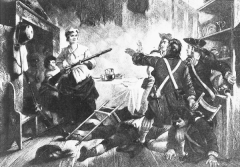
Women played various roles during the Revolutionary War. Some women accompanied their husbands when permitted. Martha Washington was known to visit the American camp, for example, and Frederika Charlotte Riedesel documented the Saratoga campaign.[505] Women also acted as spies on both sides of the Revolutionary War.[506] In some cases women served in the American Army in the war, some of them disguised as men.[507] Deborah Sampson fought until her sex was discovered and she was discharged, and Sally St. Clare died in the war.[507] Anna Maria Lane joined her husband in the Army, and she was wearing men's clothes by the time of the Battle of Germantown.[507] According to the Virginia General Assembly, Lane "performed extraordinary military services, and received a severe wound at the battle of Germantown", fighting dressed as a man and "with the courage of a soldier".[507] Other women fought or directly supported fighting while dressed as women, such as the legendary or mythical Molly Pitcher.[508] On April 26, 1777, Sybil Ludington rode to alert militia forces of Putnam County, New York and Danbury, Connecticut, warning of the approach of the British regular forces. She is referred to as the female Paul Revere.[509] Other women also accompanied armies as camp followers, selling goods and performing necessary services in hospital and camp. They were a necessary part of 18th century armies, and they numbered in the thousands during the war.[510]
Aftermath
After the surrender at Yorktown Washington expressed astonishment that the Americans had won a war against a leading world power, referring to the American victory as "little short of a standing miracle".[511] On April 9, 1783, Washington issued orders that he had long waited to give, that "all acts of hostility" were to cease immediately, and the Continental soldiers were furloughed home. That same day, by arrangement with Washington, General Carleton issued a similar order to British troops. British troops, however, were not to evacuate until a prisoner of war exchange occurred, an effort that involved much negotiation and would take some seven months to effect.[512]
Treaty of Paris

in his parliamentary robes
The conflict between British subjects with the Crown against those with the Congress had lasted over six years from 1775 Lexington to 1781 Yorktown. About three years into the conflict, France and the US struck an agreement at the Treaty of Alliance (1778) that promised those two would consult before concluding peace with Britain for US independence. Then the next year, France and Spain consorted in secret at the Treaty of Aranjuez (1779) to promise those two would fight until Spain gained Gibraltar, at the choke-point passage between the Mediterranean and the Atlantic. After the Yorktown defeat and Parliament's resolution to end American fighting, British Prime Minister Shelburne sought to separate the US from warring France by strengthening the US so it would not depend France militarily. The French long-term interest was a weak US to ensure a future military alliance against Britain.[513] Earlier Parliamentary resolutions to end offensive action in North America were extended on December 5, 1782. In a Speech from the Throne to the joint session of Parliament, George III offered the US Congress independence, peaceful trade, and ultimately to forge "a bond of permanent union between the two countries" based on religion, language, interest and affection.[513][514]
In Paris, the three Euro belligerents in the Anglo-French War floated distinctly different proposals for an "American Settlement" to apportion territory to the United States. The French had the most restrictive plan, with a western boundary for the US at the Appalachian Mountains, matching the British 1763 Proclamation Line. The Spanish allowed for some additional Mississippi River Basin upland just west of the Appalachians for the US. But it also required that the British cede its colony of Georgia to Spain in violation of the Franco-American alliance of 1778.[513]

Britain and the US signed their Preliminary Peace treaty in November 1782. The agreement met four Congressional peace demands: independence, territory to the Mississippi, navigation to the sea, and fishing off Newfoundland. Congress endorsed it by law on April 15, 1783 and proclaimed that peace with independence was achieved. The “conclusive” treaty was signed on September 3, 1783 in Paris with Britain alone. Britain had also signed preliminary agreements with France and Spain to end their European war in separate treaties, signing an additional conclusive Anglo-French Treaty of Versailles (1783) for British-French territorial settlement worldwide, and then the conclusive Anglo-Spanish Treaty of Versailles (1783) for the British-Spanish territorial settlement worldwide.[513][lower-alpha 68] The US ministers negotiating the British-US peace were John Adams, Benjamin Franklin, John Jay, and for Britain, David Hartley of Parliament and Richard Oswald, Britain's Peace Commissioner.[515] Adams, who was an early participant drafting the treaty, maintained that its negotiations represented "one of the most important political events that ever happened on the globe".[516]
Following the British defeat at Yorktown, English public will evaporated for continuing the government's war to suppress the Thirteen Colony rebellion. Three months later on February 2, 1782 the House of Commons voted against further offensive war against the US. Six weeks more, American General George Washington and British General Sir Guy Carleton entered into an end of hostilities between the belligerents at New York City.[517][lower-alpha 69]
Britain was under attack around the world from the navies of France, Spain and the Netherlands. Prime Minister Lord Shelburne sought to bring an early end to the American Revolutionary War by accepting American independence, and in hopes of separating the US from France, he met their demands for territory west to the Mississippi River. The British government could then commit the British garrisons at New York and Charleston to attack French and Spanish West Indies. To speed the US negotiators, Britain offered Newfoundland fishing rights to the US, denying France exclusive rights; France and Spain would now sign their treaties after the Anglo-American fait accompli.[519] The two separately negotiated treaties of Versailles addressed issues of mutual Great Power concern, such as a European “continental balance of power", reciprocal colonial territory swaps, and trade agreements among their respective worldwide colonial empires.[520][lower-alpha 70]
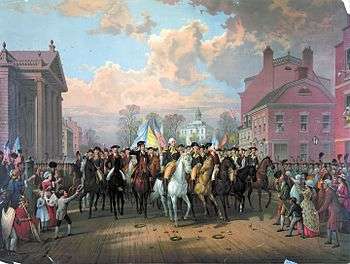
at British evacuation, November 25, 1783[lower-alpha 71]
When Spain declared war on Britain over control of Gibraltar in 1779, the resultant three year Siege of Gibraltar became involved in the American Revolutionary War, as it took away British resources that could be employed in the war on the American continent and elsewhere.[523][524] Negotiations involving Gibraltar's ultimate fate however did not involve any settlements with the United States.[525][lower-alpha 72]
As for British Indian allies in America, Britain never consulted them at any time prior to treaty negotiations, then it forced them to reluctantly accept the treaty. But the following year Britain underwrote formerly allied Indians for attacks against US settlers west of the Appalachians on territory that Britain had ceded by treaty. The largest sustained British ally Indian war of this period was the Northwest Indian War 1785–1795.[528] Britain's extended war policy on the US continued to try to establish an Indian buffer state below the Great Lakes as late as 1814 during the War of 1812.[499] However, the last uniformed British troops departed their last east coast port cities in Savannah, Charleston, and New York City, by November 25, 1783. That marked the end of British occupation in the new United States.[529]
As directed by a Congressional resolution of May 26, all noncommissioned officers and enlisted were furloughed "to their homes" until the "definitive treaty of peace", when they would be automatically discharged.[530] The US armies were directly disbanded in the field as of Washington's General Orders on Monday June 2, 1783.[531] Once the conclusive Treaty of Paris was signed with Britain, Washington resigned as commander-in-chief at Congress, leaving for his Army retirement at Mount Vernon.[515]
Territory
The expanse of territory that was now the United States was ceded from its colonial Mother country alone. It included millions of sparsely settled acres south of the Great Lakes Line between the Appalachian Mountains and the Mississippi River. The tentative colonial migration west became a flood during the years of the Revolutionary War. Virginia's Kentucky County counted 150 men in 1775. By 1790 fifteen years later, it numbered over 73,000 and was seeking statehood in the United States.[532]
|
Western lands were still populated by a dozen or so Native American tribes that had been British allies for the most part. British forts on their lands had been ceded to either the French or the British prior to the creation of the United States.[533] Although Indians were not referred to in its territorial cession to the US, the British refused to abandon their existing forts provisioning their former military allies and it sponsored the Northwest Indian War (1785-1795) until the Anglo-American Jay Treaty went into effect.[lower-alpha 73] The Spanish also sponsored war on the US by Indian proxies in its Southwest Territory.[535]
Of the European powers with American colonies, Spain was most threatened by United States independence, and it was correspondingly the most hostile to it.[lower-alpha 74] Its territory adjacent the US was relatively undefended, so Spanish policy developed a combination of initiatives. Spanish soft power diplomatically challenged the British territorial cession west to the Mississippi and the previous northern boundaries of the Floridas.[536] It imposed a high tariff on American goods, then blocked American settler access to the port of New Orleans. Spanish hard power extended war alliances and arms to Southwestern Indians to resist American settlement. A former Continental Army General, John Wilkinson settled in Kentucky County Virginia in 1784, and there he fostered settler secession from Virginia during the Spanish-allied Chickamauga Cherokee war. Beginning in 1787, he received pay as Spanish Agent 13, and subsequently expanded his efforts to persuade American settlers west of the Appalachians to secede from the United States, first in the Washington administration, and later again in the Jefferson administration.[537]
Casualties and losses
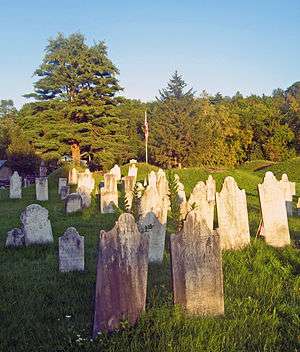
mounds of Saratoga dead behind them
The total loss of life throughout the conflict is largely unknown. As was typical in wars of the era, diseases such as smallpox claimed more lives than battle. Between 1775 and 1782, a smallpox epidemic broke out throughout North America, killing an estimated 130,000 among all its populations in those revolutionary war years.[538][lower-alpha 75] Historian Joseph Ellis suggests that Washington's decision to have his troops inoculated against the disease was one of his most important decisions.[539]
Between 25,000 and 70,000 American Patriots died during active military service.[23] Of these, approximately 6,800 were killed in battle, while at least 17,000 died from disease. The majority of the latter died while prisoners of war of the British, mostly in the prison ships in New York Harbor.[24][lower-alpha 76] The number of Patriots seriously wounded or disabled by the war has been estimated from 8,500 to 25,000.[541] The French suffered 2,112 killed in combat in the United States.[25][lower-alpha 77] The Spanish lost a total of 124 killed and 247 wounded in West Florida.[27][lower-alpha 78]
A British report in 1781 puts their total Army deaths at 6,046 in North America (1775–1779).[30][lower-alpha 79] Approximately 7,774 Germans died in British service in addition to 4,888 deserters; of the former, it is estimated 1,800 were killed in combat.[5] Around 171,000 sailors served in the Royal Navy during British conflicts 1775–1784; approximately a quarter of whom had been pressed into service. Around 1,240 were killed in battle, while an estimated 18,500 died from disease (1776–1780).[31] The greatest killer at sea was scurvy, a disease caused by vitamin C deficiency.[421][lower-alpha 80] Around 42,000 sailors deserted worldwide during the era.[16] The impact on merchant shipping was substantial; 2,283 were taken by American privateers.[337][lower-alpha 81]
See also
- 1776 in the United States: events, births, deaths & other years
- Timeline of the American Revolution
Topics of the Revolution
- American Continental Army
- Committee of safety (American Revolution)
- Diplomacy in the American Revolutionary War
- Financial costs of the American Revolutionary War
- Flags of the American Revolution
- Intelligence in the American Revolutionary War
- Naval operations in the American Revolutionary War
Social history of the Revolution
- Black Patriot
- Christianity in the United States#American Revolution
- The Colored Patriots of the American Revolution
- History of Poles in the United States#American Revolution
- List of clergy in the American Revolution
- List of Patriots (American Revolution)
- Loyalists fighting in the American Revolution
- Quakers in the American Revolution
- Scotch-Irish Americans#American Revolution
Others in the American Revolution
Lists of Revolutionary military
- List of American Revolutionary War battles
- List of British Forces in the American Revolutionary War
- List of Continental Forces in the American Revolutionary War
- List of infantry weapons in the American Revolution
- List of United States militia units in the American Revolutionary War
"Thirteen Colony" economy
Legacy & related
- American Revolution Statuary
- Commemoration of the American Revolution
- Independence Day (United States)
- The Last Men of the Revolution
- List of plays and films about the American Revolution
- Museum of the American Revolution
- Tomb of the Unknown Soldier of the American Revolution
- United States Bicentennial
Bibliographies
- Bibliography of the American Revolutionary War
- Bibliography of Thomas Jefferson
- Bibliography of George Washington
Notes
- Peace process: March 1782-Parliament recommends George III make peace. December 1782-George III Speech from the Throne for US independence. April 1783-Congress accepts British proposal that meets its four demands. September 1783-conclusive treaty of peace by Britain and US. May 1784-Diplomats in Paris exchange the subsequent ratifications by Parliament and Congress.[1]
- The American Revolutionary War was primarily fought by the Thirteen Colonies that became thirteen states independent of British Parliament.[3] June 12, 1776: Virginia allegiance to the Crown was maintained, but the political rule by "King-in-Parliament" was DISSOLVED. It was replaced by a new constitution, in force unless another one acceptable to Congress was adopted soon. New states used the "Grand Union Flag" of Congress
.svg.png)
- Each of the Thirteen Colonies that became states in the United States maintained separate militias established before their unanimous Declaration of Independence. These worked in a rough cooperation with Continental Army forces. Individual state legislatures controlled field promotions among their State Line regiments within the Continental Army below the rank of Brigadier General. For the most part, citizens in state militia units stayed within their home states.
- Vermont's Green Mountain Boys of Vermont were settlers known in the Continental Congress as the New Hampshire Grants to New York. They secured British-held Fort Ticonderoga, and then attached to the Continental Army as a ranger regiment from June 1775 to 1778 at Vermont’s separate declaration of independence from Great Britain. Vermont was admitted to the Union as the 14th state in 1791.
- France became an ally with the US for independence 1778-1781, until the US and Britain began bi-lateral negotiations without France. The 1778 French-US treaty was meant to be a defensive alliance with "the direct and essential end", to (1) maintain the independence of the US from Britain, and (2) maintain US sovereignty in British-ceded North American territory (see Art. II).[4] The French-US treaty as a military alliance was to become effective were a war to break out between France and Great Britain (see Art. I).[4] A French and British war did subsequently break out when France initiated the Anglo-French War (1789).
- Spain is also considered a co-belligerent of the US, fighting Britain at the same time as the US over two years, 1779–81. As early as 1776, the enlightened King Charles III of Spain unofficially funneled aid to George Washington via Fort Pitt to circumvent the British blockade of Atlantic seaboard ports. Spain refused to join the Franco-American Alliance of 1778 guaranteeing US independence, but when it joined France in a secret Treaty of Aranjuez (1779), it declared war on Britain, and Spanish Louisiana Governor Bernardo Gálvez then cleared the Mississippi River of the British with Mexican, Puerto Rican, Cuban, and Dominican soldiers; the Americans now had free travel up and down the Mississippi and Ohio Rivers. Gálvez then cut off British aid to southeastern Indian allies by taking Mobile and Pensacola. Gálvez's continuing supply to the American cause allowed Virginia militia Colonel George Rogers Clark to capture Western Quebec (US Northwest Territory), which was ceded by Britain to the US in the Treaty of Paris (1783), west to the Mississippi River.
- The Dutch Republic was a co-belligerent of the US fighting Britain in the North Atlantic 1780-1781. The government and citizens traded with New York as an English port since 1664, and by 1780 during the Revolution, they so threatened the British that they initiated the Fourth Anglo-Dutch War and swept Dutch commerce from the seas. John Paul Jones received diplomatic and material assistance after his capture of the British HMS Serapis, and Dutch bankers made loans to the Continental Congress at crucial times.
- (until 1779)
- (from 1779)
- Arnold served on the American side from 1775–1779; On the British side from 1780–1783.
- 1780–1783
- "Of 7,500 men in the Gibraltar garrison in September (including 400 in hospital), some 3,430 were always on duty".[14]
- Contains a detailed listing of American, French, British, German, and Loyalist regiments; indicates when they were raised, the main battles, and what happened to them. Also includes the main warships on both sides, And all the important battles.
- The strength of a Hanoverian battalion who where serfs of the British George III, were shipped to Gibraltar is listed as 473 men.[19]
- 7,000 dead total world wide[25]
- From 1779, Spain allied with France in its war against Britain in the Treaty of Aranjuez (1779); it made a separate peace with Britain at the Anglo-Spanish Treaty of Versailles (1783). Spain gained East Florida, West Florida and Minorca. Participation in the Anglo-French War (1779–83) cost the Spanish Empire 5,000 dead total globally,[27]
371 in British West Florida,[28]
and 4,000 dead in British prison ships.[29]
Globally, it lost 8 ships-of-the-line, and 11 frigates.[26] - Britain declared war on the Netherlands to end its trade and military aid to its rebelling Thirteen Colonies in North America. Peace came with the Treaty of Paris (1784). The Dutch war with Britain cost 500 dead worldwide.[27]
- The scope of the American Revolutionary War between the US Congress and Great Britain is dated 1775-1783 and ends formally at the Treaty of Paris (1783), signed exclusively between Britain and the US. For further clarification, reference two mainstream scholarly references that are used throughout the English-speaking world at Further reading : Britannica and Kohn, 2013, Dictionary of War, "American Revolution (1775–83)", p. 13
- This article primarily refers to the inhabitants of the thirteen colonies who supported the American Revolution as "Americans", with occasional references to "Patriots" or “Revolutionaries” supporting the Congress or to "Loyalists" or “Tories” who supported the Crown. The geographical area of the thirteen colonies is often referred to simply as "America".
- The colony of Georgia joined the Continental Congress later. The fourteenth state, Vermont Republic was independently established 1777-1791 before its admission to the US.
- By 1776, all of the original Thirteen Colonies were Royal Colonies except the Pennsylvania and Delaware colonies that were jointly ruled by the Penn family proprietorship; they also allowed governor's council members to be native-born (Spanish, "creole").
- The phrase "Boston Tea Party" had not yet become standard in 1774. Unlike Currier's depiction, only a few of the men dumping tea were disguised as Indians.[41]
- Ammerman points out that the act only permitted soldiers to be quartered in unoccupied buildings—although they were still private property. (Ammerman, In the Common Cause, 10)[46]
- Georgia did not attend.
- An alternative plan called for an imperial legislature made up both of Parliament and of a new North American "Grand Council" that would be equivalent to Parliament. It was rejected in Congress by a six to five vote on October 22, 1774. Some of its earlier support may have been chilled at the arrival of the Massachusetts Suffolk County Resolves petitioning for economic boycott, no British tax payments, and calling up local militias by the rump colonial legislatures comprised only of the elected representatives.[51]
- "Resolved, 4. That the foundation of English liberty, and of all free government, is a right in the people to participate in their legislative council: … they are entitled to a free and exclusive power of legislation in their several provincial legislatures, where their right of representation can alone be preserved, in all cases of taxation and internal polity, subject only to the negative of their sovereign, …: But, … we cheerfully consent to the operation of such acts of the British parliament, as are bonafide, restrained to the regulation of our external commerce, for the purpose of securing the commercial advantages of the whole empire to the mother country, and the commercial benefits of its respective members; excluding every idea of taxation internal or external, [without the consent of American subjects]." quoted from the Declarations and Resolves of the First Continental Congress October 14, 1774.
- George Washington standing to receive the appointment, John Adams in a blue coat, two figures to the right of him
- Quebec was officially ceded in 1763
- Irish Protestants who had been among the families immigrating to the colonies favored the Americans, while Catholics who were generally disenfranchised there favored the King.[114]
- That number was the largest army it had ever sent outside Europe at the time.
- Casualty numbers vary slightly with the Hessian forces, usually between 21–23 killed, 80–95 wounded, and 890–920 captured (including the wounded).[164]
- In a subsequent treaty France secretly made with Spain struck at Aranjuez, France aimed to expel Britain and deny the Americans from the Newfoundland fishery, end restrictions on Dunkirk sovereignty, regain free trade in India, recover Senegal and Dominica, and restore the Treaty of Utrecht provisions pertaining to Anglo-French trade.[210]
- On April 12, 1779, Spain signed the secret Treaty of Aranjuez with France and went to war against Britain. Spain made war on Britain to recover Gibraltar and Menorca in Europe, as well as Mobile and Pensacola in Florida. Spain also had an imperial interest in expelling the British from Central America, both militarily and commercially.[219]
- Mahan maintains that Britain's attempt to fight in multiple theaters simultaneously without major allies was fundamentally flawed, citing impossible mutual support, exposing the forces to defeat in detail.[233]
- Grenier maintains that "The slaughter the Indians and rangers perpetrated was unprecedented.[250]
- Light Horse Harry was the father of Robert E. Lee.[270]
- Governor Bernardo de Gálvez is only one of eight men made honorary US citizens for his service in the American Cause. see Bridget Bowman (29 December 2014). "Bernardo de Gálvez y Madrid's Very Good Year". Roll Call. The Economist Group. Retrieved April 25, 2020.
- They had been sent south to Virginia in August to coordinate with de Grasse in defeating Cornwallis.[295][296] Following two previous calamitous joint operations at Newport and Savannah by French (at sea) and Americans (on land), French planners realized that closer cooperation with the Americans was required to achieve success.[297] The French fleet led by the Comte de Grasse had received discretionary orders from Paris to assist joint efforts in the north if naval support was needed.[298][299]
- Despite the continued urging of his subordinates,[301] Cornwallis made no attempt to break out and engage the Franco-American army before it had established siege works, expecting that reinforcements would arrive from New York, and the Franco-American army laid siege to Yorktown on September 28.[303] Cornwallis continued to think that relief was imminent from Clinton, and he abandoned his outer defenses which were immediately occupied by American troops—serving to hasten his subsequent defeat.[304]
- A white flag was raised and a British officer emerged from the earthworks, along with a drummer boy. An American officer came forward to meet them, and after a brief discussion, the British officer was blindfolded and escorted to Washington's headquarters about a mile away. Upon arrival the British officer presented Washington with a letter from Cornwallis confirming the surrender. After consulting with his staff, Washington gave his written response and arranged for a meeting with Cornwallis the next morning.
- Three branches of the United States Military forces trace their institutional roots to the American Revolutionary War; the Army comes from the Continental Army; the Navy recognizes October 13, 1775, as the date of its official establishment when the Continental Congress created the Continental Navy, appointing Esek Hopkins as the Navy's first commander.[320] The Marine Corps links to the Continental Marines of the war, formed by a resolution of Congress on November 10, 1775.[321]
- The largest force Washington commanded was certainly under 17,000,[326] and may have been no more than 13,000 troops, and even the combined American and French forces at the siege of Yorktown amounted to only about 19,000.[327]
- On the British side, their armies were relatively smaller due to the difficulty of transporting troops across the Atlantic. They were also limited by their dependence on local supplies, which the Patriots tried to cut off. By comparison, Duffy notes that in an era when European rulers were generally revising their forces downward, in favor of a size that could be most effectively controlled (the very different perspective of mass conscript armies came later, during the French Revolutionary and then the Napoleonic Wars), the largest army that Frederick the Great ever led into battle was 65,000 men (at Prague in 1757), and at other times he commanded between 23,000 and 50,000 men, considering the latter the most effective number.[327]
- For instance, cattle-feeders could not use Congressional certificates to buy yearlings to fatten, nor would grain sellers honor them for feed. States netted as little as 10% their annual revenues in inflated Continental dollars, the rest in certificates that could not be used to pay their state requisitions to Congress to fund the Army.
- Requisitions for wheat to Connecticut had no effect because there was little wheat production there. Pennsylvania had to import its requisitions of bacon and salt from other states with inflated currency. Congressional orders for salted beef and pork were placed after marketing season, so states had to obtain the supplies through hording speculators. The previous year’s drought in Rhode Island had killed all the state’s cattle. The 1780 harvest was poor in New York. Virginia’s Chesapeake Bay was effectively blockaded.
- Congress tried to motivate the Quartermaster and Commissary Departments in the Continental Army independently from local politics by compensating them on commission. That led to local charges of corruption by local profiteers and others on Puritanical principles.
- State requisition laws were designed to minimize the pain of local citizenry and to maximize delay to the Continental Army. In the worst case by law, a requisition passed in October 1780 was to begin county implementation February 1781, with fifty days for individual farmers to comply, and another 30 days of appeal time. Regardless of legislated schedules, in many cases local officials refused to pressure their voting neighbors. They accepted their salaries, “without ever supposing it incumbent on them to discharge the duties thereof” according to Deputy Quartermaster Edward Carrington, April 1781.
- These included Generals John Sullivan (NH), Ezekiel Cornell and James Mitchell Varnum (RI), and other staunch nationalists were returned such as clergyman John Witherspoon (NJ).
- During this time Benjamin Church, an assumed trusted patriot, was giving the British information on patriot troop strength and positions.[357]
- The city only occupied the southern tip of Manhattan in 1776.
- Tallmadge's cover name became John Bolton, and he was the architech of the spy ring.[361]
- Four of their names were revealed in the 1920s through the research of archivist Morton Pennypacker. The ring leader's identity, however, has yet to be discovered.[362] Other members of the ring included Robert Townsend and Caleb Brewster.[361]
- Arnold managed to escape, while André was captured and hanged on October 2.[366]
- Figures include the 41st regiment of invalids, but not the 20 independent companies on garrison duty. Troops in India were under the control of the East India Company, and did not become part of the British Army until 1858.[378]
- Standing armies had played a key role in the purge of the Long Parliament in 1648.[379]
- The naval standoff at Cape Henry was at considerable cost to Arbuthot's professional reputation. He had disrupted the chain of command during war, the he was subsequently embarrassed by the admiralty supporting his successor. And he tactically mishandled his fleet in line, misjudging the wind and causing three of his eight ships to be put out of action during battle. It was only the prevailing wind that allowed his limping withdrawal towards the mouth of the Chesapeake, which was coincidentally his tactical goal. Arbuthnot was given no further command at sea thereafter.[398]
- This lack of notification was one of Clinton's main arguments in his own defense in the controversy that followed the surrender at Yorktown.[400]
- A Private infantryman was paid a wage of just 8d. per day,[424] the same pay as for a New Model Army infantryman, 130 years earlier.[425]
- After the defeat at Saratoga, Parliament doubled the bounty to £3,[430] and increased it again the following year, to £3.3s, as well as expanding the age limit from 17–45 to 16–50 years of age.[431]
- The lower ranks often regarded the treatment to high-ranking commissions by wealthier officers as "plums for consumption".[449]
- Royal authority had forbidden the practice since 1711, but it was still permitted for infants to hold commissions. Young boys were taken from their schooling, often orphans of deceased wealthy officers, and placed in positions of responsibility within regiments.[451]
- Hessians sent to America:
Brunswick (5,723)
Hesse-Kassel (16,992)
Hesse-Hannau (2,422)
Ansbach-Bayreuth (2,353)
Waldeck-Pyrmont (1,225)
Anhalt-Zerbst (1,160).
Total: 29,875
Of these more than 18,000 sailed to America in 1776.[18] In the case of a seventh German principality, Parliament approached King George III to lend the government Hanoverian soldiers for war service because he personally ruled Hanover as a Prince-elector of the Holy Roman Empire. Hanover supplied 2,365 men in five battalions. However the lease agreement permitted only European deployment. They were subsequently garrisoned in fortress at Gibraltar where they could not desert as easily as in American service.[456] - Historians have estimated that Loyalists made up only 15- to 20-percent of the population (vs. 40- to 45-percent Patriots)[461] and that they continued to deceive themselves on their level of support as late as 1780, only a year before the close of hostilities.[462]
- On militia see Boatner (1974), p. 707;
Weigley (1973), ch. 2 - "British Legion Infantry strength at Cowpens was between 200 and 271 enlisted men". However, this statement is referenced to a note on pp. 175–76, which says, "The British Legion infantry at Cowpens is usually considered to have had about 200–250 men, but returns for the 25 December 1780 muster show only 175. Totals obtained by Cornwallis, dated 15 January, show that the whole legion had 451 men, but approximately 250 were dragoons". There would therefore appear to be no evidence for putting the total strength of the five British Legion Light Infantry companies at more than 200.[468]
- A microcosm of these shortcomings were evident at the Battle of Bunker Hill. It took ten hours for the British leadership to respond following the sighting of the Americans on the Charlestown Peninsula, giving the colonists ample time to reinforce their defenses.[473] Rather than opt for a simple flanking attack that would have rapidly succeeded with minimal loss,[474] the British decided on repeated frontal attacks with heavy casualties, until the patriots ran out of ammunition, gunpowder being in short supply. The results were telling; the British suffered 1,054 casualties of a force of around 3,000 after repeated frontal assaults.[475] The British leadership had nevertheless remained excessively optimistic, believing that just two regiments could suppress the rebellion in Massachusetts.[472][476]
- Europe's "Great Powers" of the late 1700s were the western powers of France, Spain and Britain, along with the eastern powers of Austria, Russia and Prussia. The three eastern powers all offered to mediate Great Power conflicts, Russia began as the mediator among the three Western powers until it showed favoritism to Britain, at which time the Austrians took over the role.
- Note:Previously, French and Spanish ministers had insisted to continue their imperial war against Britain until concluding a comprehensive European peace prior to recognizing US independence. Also, the secret 1779 French-Spanish treaty first secured the Bourbon kings naval superiority over Britain in European and Mediterranean waters, but the price for Spanish commitment was continued French warfare against Britain until after Gibraltar had fallen to Spanish possession.
- On March 5, 1782, Both Commons and Lords of Parliament authorized the government to make a US peace with independence.[518] Parliament began its negotiations in Paris, and a British-US-French-Spanish armistice was negotiated there, and subsequently honored in North America among all sides, thus ending conflict related to the American War for Independence.[312]
- Preliminary peace articles to end the American Revolutionary War were signed in Paris between UK and US on November 30, 1782. The US Congress ratified the Treaty of Paris on April 13, 1783, securing independence from Britain in that treaty between the two belligerents as separate and equal nations.[521] Congress then proclaimed an end to all hostilities that same day.[522]
- St. Paul's Chapel is shown on the left. However, the parade route in 1783 did not pass by it, but went from Bull's Head Tavern on Bowery near Bayard, then continuing down Chatham, Pearl, Wall, and ending at Cape's Tavern on Broadway.
- Negotiations over Gibraltar were not submitted to US ministers in Paris, neither by British, Spanish nor French governments. U.S. independence was recognized by treaty with France February 6, 1778,[525] by preliminary agreement with Britain in November 1782[526] and George III announcement December 5, 1782, and by treaty with Spain in March 1783.[527] None of them returned to the negotiation table with Benjamin Franklin or John Jay to settle on how Gibraltar should be disposed of.
- For the next thirteen years until the Anglo-American commercial Jay Treaty of 1796 under President John Adams, the British maintained five forts in New York state: two forts at northern Lake Champlain, and three beginning at Fort Niagara stretching east along Lake Ontario. In the Northwest Territory, they garrisoned Fort Detroit and Fort Michilimackinac.[534]
- There had been native-born Spanish (hidalgo) uprisings in several American colonies during the American revolution, contesting mercantilist reforms of Carlos III that had removed privileges inherited from the Conquistadors among encomiendas, and they also challenged Jesuit dominance in the Catholic Church there. American ship captains were known to have smuggled banned copies of the Declaration of Independence into Spanish Caribbean ports, provoking Spanish colonial discontent.
- In addition to as many as 30% deaths in port cities, and especially high rates among the closely confined prisoner-of-war ships, scholars have reported large numbers lost among the Mexican population, and large percentage losses among the Native Americans along trade routes, Atlantic to Pacific, Eskimo to Aztec.
- If the upper limit of 70,000 is accepted as the total net loss for the Patriots, it would make the conflict proportionally deadlier than the American Civil War.[540] Uncertainty arises from the difficulties in accurately calculating the number of those who succumbed to disease, as it is estimated at least 10,000 died in 1776 alone.[5]
- Elsewhere around the world, the French lost another approximately 5,000 total dead in conflicts 1778-1784.[25]
- During the same time period in the Fourth Anglo-Dutch War, the Dutch suffered around 500 total killed, owing to the minor scale of their conflict with Britain.[27]
- British returns in 1783 listed 43,633 rank and file deaths across the British Armed Forces.[32] In the first three years of the Anglo-French War (1778), British list 9,372 soldiers killed in battle across the Americas; and 3,326 in the West Indies (1778–1780).[30] In 1784, a British lieutenant compiled a detailed list of 205 British officers killed in action during British conflicts outside of North America, encompassing Europe, the Caribbean and the East Indies.[542] Extrapolations based upon this list puts British Army losses in the area of at least 4,000 killed or died of wounds outside of its North American engagements.[5]
- It was not until 1795 that scurvy was eradicated from the Royal Navy after the Admiralty declared lemon juice and sugar were to be issued among the standard daily grog rations of sailors.[543]
- Worldwide 1775-1784, an estimated 3,386 British merchant ships were seized by enemy forces during the war among Americans, French, Spanish, and Dutch.[544]
Citations
- Year dates enclosed in [brackets] denote year of original printing
- Maryland State Archives, MSA SC 1556-40, 2007
- Simms, 2009, pp. 615–618
- Hening, 1821 Chap. II
- Peters, 1846, Library of Congress, pp. 6, 8
- Duncan, 1931
- Lanning, 2009, pp.195–196
- Greene & Pole, 2008, p. 328
- U.S. Merchant Marine, 2012
- Paullin, 1906, pp. 315–316
- Montero, 1860, p. 356
- Dull, 1987, p. 110
- Essay: Red Coats Facts, Totally History.com, 2012
- Rinaldi, Essay, The British Army 1775—1783
- Chartrand, 2006, p. 63
- Winfield, 2007
- Mackesy, 1993 [1964] , pp. 6, 176
- Savas & Dameron, 2006, p. xli
- Lowell, 1884, p. 20
- Knesebeck, 2017 [1845] , p. 9
- Greene & Pole, 2008, p. 393
- Boatner, 1974 [1966] , p. 545
- Duncan, 1931, p. 370
- Peckham, (Ed.), 1974
- Burrows, 2008, Patriots or Terrorists, Issue 5
- Dawson, Essay, 2017
- Clodfelter, 2017, p 133
- White, 2010: Essay
- Otfinoski, 2008, p. 16
- Archuleta, 2006, p. 69
- Parliamentary Register, 1871, pp. 263–265
- Parliamentary Register, 1871, p. 269
- Burke (ed), 1785, pp. 199–200
- Burrows, 2008, Forgotten Patriots, p. 203
- O'Shaughnessy, 2013, p. 179
- Bonwick, 1991, pp. 71–72
- Gladney, 2014, p. 5
- Dickinson, 1977, p. 218
- McIlwain, 2005 [1938] , p. 51
- Boyer, 2014, p. 142
- Ferling, 2002, pp. 72–73
- Young, 1999, pp. 183–85
- Ferling, 2007, p.23
- Greene & Pole, 2008, p. 155–156
- Avalon Project, 2008, Massachusetts Government Act
- Christie, 1976, p. 188
- Ammerman, 1974, p. 9
- Ammerman, 1974, p. 15
- Nash, 2007, pp. 184–185
- Ferling, 2003, p. 112
- Kramnick (Ed.), Paine, 1982, p. 21
- Greene & Pole, 2008, pp. 338–339
- Ferling, 2007, pp. 62–64
- Axelrod, 2009, p. 83
- Fischer, p. 76
- Mays, 2019, p. 3
- Taylor, 2016, pp. 141–142
- Davis, 1975, pp. 11–13
- Bell, 2005, pp. 3–4
- Ferling, 2007, pp. 286–287
- Lengel, 2007, pp. 365–71
- Ellis, 2004, pp. 92–109
- Rose, 2007, pp. 258-261
- Ferling, 2007, p. 29
- Fischer, p. 85
- Ketchum, 2014, pp. 18, 54
- Ketchum, 2014, pp. 2–9
- Ketchum, 2014, p. 110–111
- Adams, 1963 [1895-1896] , pp. 401–413
- Ketchum, 2014, pp. 183, 198–209
- Rankin, 1987, p. 63
- Higginbotham, 1983 [1971] , pp. 75–77
- Taylor, 2016, pp. 141–142
- Davis, 1975, pp. 11–13
- Lecky, 1892, vol. 4, pp. 449–450
- McCullough, 2005, p. 53
- Frothingham, pp. 100–01
- Ferling, 2003, p. 183
- Alden, 1989, pp. 188–190
- Smith (1907), vol 1, p. 293
- Glatthaar (2006), p. 91
- Glatthaar (2006), p. 93
- Smith (1907), vol 1, p. 242
- Greene & Pole, 2008 [2000] , pp. 504–505
- Alden, 1975, p. 206
- Randall, 1990, MHQ Journal, pp. 38-39
- Lanctot (1967), pp. 141–46
- Stanley, pp. 127–28
- Watson (1960), p. 203
- Lefkowitz, 2007, pp. 264–265
- Smith (1907), volume 2, pp. 459–552
- Selby, 2007, p. 2
- Levy, 2007, p. 74
- Scribner & Van Schreeven, 1983, p. xxiv
- Russell, p. 73
- McCrady, 1901, p. 89
- Landrum, 1897, pp. 80–81
- Wilson, 2005, p. 33
- Hibbert, 2008, p. 106
- Kepner, 1945, pp. 93–103
- Bicheno, 2014, pp. 154, 158
- Field, 1898, p. 104
- McCusker, 1997, pp. 185–87
- Riley, pp. 101–02
- Field, 1898, pp. 117–18
- Field, 1898, pp. 120–25
- Ferling, 2003, p. 38, 113
- Ketchum, p. 211
- Maier, 1998, p. 25
- Middlekauff, 2007 [1984] , p. 168
- Ferling, 2003, pp. 123–124
- O'Shaughnessy, 2013, p. 186
- Biletx, 2013, p. 8
- Lecky, 1892, vol. 4, pp. 162–165
- Morley, 2002, pp. 154–57
- Ketchum, pp. 208–09
- Frothingham (1903), p. 298
- Miller, 1959, pp. 410–12
- Scheer & Rankin, 1959, p. 64
- Smith, 2012, pp. 21–23
- Christie, 1976, pp. 31–32
- Maier, 1998, pp. 33–34
- McCullough, 2005, pp.119-122
- Maier, 1998, pp. 55-56, 99–105
- Ferling, 2007, pp. 112, 118
- National Archives: Declaration of Independence, 1776
- Boyd, Evolution, 19
- Maier, 1998, pp. 160–61
- Fischer, 2004, p. 29
- Maier, 1998, pp. 156–157
- Mays, 2019, p. 2
- Maier, 1998, p. 152
- Boatner, 1974, p.1094
- Jasanoff, 2012, p. 28
- Bonwick, 1991, p. 152
- Encyclopedia of American History Richard B. Morris and Jeffrey B. Morris, eds., 6th Edition (New York: Harper & Row Publishers, 1982), p. 130
- Flight of the Tories from the Republic, The Tories of the American Revolution. North Callahan (1967) p. 120
- Land Confiscation Records of North Carolina, Vol. 1 (1779–1800) Stewart Dunaway, p. 9
- Fischer, pp. 76–78
- Ketchum, 1973, p. 104
- Fischer, pp. 89, 381
- Adams, 1896 [1963] , p. 657
- Fischer, pp. 88–102
- McCullough, 2005. pp. 184–186
- Ketchum, 1973, p. 117
- McGuire, 2011, pp. 165–166
- Fischer, pp. 102–07
- Fischer, 2004, pp. 102–111
- Barnet Schecter, The battle for New York: The city at the heart of the American Revolution (2002)
- Ketchum pp. 111, 130
- Fischer, pp. 109–25
- McCullough, 2005, p. 122
- Stedman, 1794, Vol. 1, p. 221
- Lowenthal, 2009, pp. 61, 131
- Tucker, 2002, pp.22–23
- Stedman, 1794, Vol. 1, p. 223
- Schecter, pp. 266–67
- Fischer, pp. 138–42
- Lecky, Vol.4, 1892, pp. 70–78
- McCullough, 2005, p. 195
- Ketchum, 1973, pp. 191, 269
- Adams, 1963 [1895–1896] , pp. 650–670
- Schecter, pp. 259–63
- Fischer (2004), pp. 206–59
- Fischer p. 254
- Wood, 1995, pp. 72–74
- Fischer p. 307
- Ketchum p. 286
- Ketchum, 1973, pp. 388–389
- Schecter, p. 268
- McCullough, 2005, p. 290
- Lengel, 2007, p. 208
- Fischer (2004), pp. 345–58
- Lecky, Vol.4, 1892 p.57
- Ketchum (1997), p. 84
- Ketchum, 1997, p.84
- Ketchum (1997), pp. 244–49
- Gabriel, 2012, p. x
- Ketchum (1997), p. 283
- Ketchum, 1997, pp. 337–78
- Ketchum, 1997, pp. 403–25
- Stedman, 1794, Vol. 1, pp. 287–89
- Higginbotham, 1983 [1971] , p. 181
- Adams, 1911, p. 43
- Ward, 1952, p. 362
- Stephen R. Taaffe, The Philadelphia Campaign, 1777–1778 (2003), pp. 95–100 excerpt and text search.
- Rose, 2013, p. 20
- McGuire, 2011, p. 254
- Cadwalader, 1901, pp. 20–21
- Freedman, 2008, pp. 1–30
- Paul Douglas Lockhart, The Drillmaster of Valley Forge: The Baron de Steuben and the Making of the American Army (2008)
- Noel Fairchild Busch, Winter Quarters: George Washington and the Continental Army at Valley Forge (Liveright, 1974)
- "A Concluding Commentary" Supplying Washington's Army (1981)
- "The Winning of Independence, 1777–1783" American Military History Volume I (2005)
- Kennedy, 2014, p. 163
- Text incorporated from Valley Forge National Historical Park website, which is in the public domain
- Freedman, 2008, pp. 70–83
- Ferling, 2007, pp.117–118
- Jones, 2002, p. 5
- Hoffman, Ronald, and Peter J. Albert, eds. Diplomacy and Revolution: The Franco-American Alliance of 1778 (United States Capitol Historical Society, 1981)
- Lemaître, 2005, p. 229
- Paterson, 2009, pp. 13–15
- Journal of the American Revolution, "The Gunpowder shortage" (September 9, 2013).
- James Brown Scott, Historical Introduction, pp. 8–9 in Samuel Flagg Bemis, Ed. The American Secretaries of State and their diplomacy V.1–2, 1963
- NPS, Essay, 2013
- Reid, Authority to Tax, 51
- Stockley, 2001, pp. 11–14
- Perkins, James Breck, France In The Revolution (1911)
- Corwin, Edward Samuel, French Policy and the American Alliance (1916), pp. 121–48
- Morris, 1965, p. 15
- Renaut, 1922, p. 290
- Caughey, 1998, p. 87
- Mitchell, 2012, p. 99
- Ward, 1952, pp.557–558
- Ferling, 2007, p. 283
- Chávez, 2002,pp. 52–54
- Sparks (ed), 1829, pp. 7, 20, 409
- Fernández, 1885, p. 4
- Clarfield, 1992
- Stockley, 2001, p. 19
- Edler, 1911, pp. 28–32
- Edler, 1911, pp. 42–62
- Edler, 1911, p. 95–138
- Edler, 1911, p. 62–69
- Edler, 1911, pp. 88–91, 151–154, 164
- Ferling, 2007, p. 294
- Syrett (1998), p. 17
- Scott, 1990, pp. 264–272
- Cf. Richard Pares, (1936): 429–65
- Syrett, 1998, p. 18
- Ketchum, 1997 pp. 405–48
- Higginbotham, 1983 [1971] , pp. 175–188
- Trevelyan (1912), vol. 1, pp. 4–5
- Mahan, 1890, p. 534
- Morrissey, 2004, pp. 77–78
- Daughan, 2011, pp. 174–176
- Hazard, 1829, p. 54
- Nelson, 1990, p. 170
- Bicheno, 2014, p. 149
- Fischer, 2008, p. 86
- Alfred, 1871, p. 49
- Tolson, Jay (July 7–14, 2008). "How Washington's Savvy Won the Day". U.S. News & World Report
- Chandler, 2017, pp. 363–380
- Fleming, 1973, pp. 174–175
- Fleming, 1973, pp. 232, 302
- Palmer, 2010, p. 340–342, 410
- Waallace, 1954, pp. 263, 270
- Nester, 2004, p. 194
- Nelson, Man of Distinction, p. 101
- Harrison, 2001, pp. 58–60
- Grenier, 2005, p. 159
- Nelson, 1999, p. 118
- Gaff, 2004, p. 85
- Skaggs, 1977, p. 132
- Lumpkin, 2000, pp. 51–53
- Morrill, 1993, pp.46–47
- Morrill, 1993, pp.48–50
- Wilson, 2005, p. 112
- Lumpkin, 2000, p. 60
- Gordon & Keegan, 2007
- Bicheno, 2014
- Hugh F. Rankin, North Carolina in the American Revolution (1996)
- Buchanan, 1997, p. 202
- Clinton, H.; The American Rebellion; 1783
- Buchanan, 1997, p. 326
- Buchanan, 1997, p. 275
- Buchanan, 1997, p. 241
- Peterson, 1970, pp. 234–38
- Meacham, 2012, pp. 133–35; Ellis, 1996, p. 66; Gordon-Reed, 2008, pp. 136–37
- Papers of Thomas Jefferson, Volume 4, p. 343
- Buchanan, 1997, p. 352
- Ferling, 2007, pp.494, 497–498
- Buchanan, 1997, pp. 374, 382
- Lumpkin, 2000, pp. 5–6
- Ferling, 2007, pp. 518–519
- Greene, 1913, pp. 234-237
- Cate, 2006, p. 162
- Reynolds, 2012, pp. 255–277
- Pancake, 1985, p. 221
- Butterfield, Consul W. History of George Rogers Clark's Conquest of the Illinois and the Wabash Towns 1778–1779 (1903) Columbus, Ohio: Heer, p.123–124
- James, 2013, p. 157
- Chávez, 2002, p. 170
- Don Jaun Carlos I, 1979, speech
- Louisiana State Museum at the Cabildo, exhibit May 14, 2018, viewed April 25, 2020
- Chavez, 2002, p.108
- Raab, 2007, p. 135
- O'Brien, 2008, p. 124
- Mahan, 1898, p. 226
- Bailey, 1994, p. 120
- Ferling, 2007, p. 444
- Grainger, 2005, p. 29
- Ketchum, 2014, pp. 423, 520
- Ketchum, p. 139
- Grainger, 2005, pp. 43–44
- Ferling,m 2007, p. 524
- Johnston, 1881, pp. 101
- Ferling, 2007, pp.526–529
- Dull, 2015 [1975] , pp. 247–248
- Grainger, 2005, p. 40
- Dull, 1987, p. 241
- Taylor, 2016, pp. 293–295
- Ketchum, p. 205
- Lengel, 2007, p. 337
- Ketchum, p. 214
- Lemgel, 2007, p. 337
- Middleton, 2014, pp. 29–43
- Duffy, 1992, p. 110
- Dale, 2005, pp.36–37
- Fleming, 1973, pp.16, 307–308
- Ferling, 2007, pp. 534–535
- Hibbert, 2000, p. 160
- Hibbert, 2000, p. 160–61
- Greene & Pole, 2008 [2000] , p. 325
- Hibbert, 2008, p. 333
- Hibbert, 2000, p. 164
- namier1985, p. 246
- Mackesy, 1993 [1964] , p. 435
- Mays, 2019, p. 1
- Greene & Pole, 2008 [2000] , ch. 36–39
- Black, 2001, p. 59
- Miller, 1997 [1977] , pp. 11-12, 16
- Smith, 2014, pp. iv, 459
- Carp, 1990, p. 220
- Freeman & Harwell (ed.), p. 42
- Higginbotham, 1971, Chap.3
- Higginbotham, 1971, Chap.3
- Boatner, 1974, p. 264
- Duffy, 2005 [1987] , p. 13
- Crocker, 2006, p. 51
- Higginbotham, 1971, Chap.3
- Ferling, 2007, pp. 294–295
- Ferling, 2007, p. 360
- Miller, 1997 [1977] , pp. 11-12, 16
- Smith, 2014, pp. iv, 459
- Higginbotham (1983), pp. 331–46
- Thomas, 2017, article #184
- Daughan, 2011, p. 240
- Pike, 1907, Essay
- Cook, 1959, pp. 275-304
- Davies, 1939, pp. 283–294
- Philbrick, 2016, p. 237
- Carp, 1990, p 178
- Carp, 1990, p 186
- Baack, “The Economics of the American Revolutionary War”, EH.net
- Carp, 1990, p 186
- Carp, 1990, p 182-3
- Carp, 1990, p 220
- Carp, 1990, p 186-7
- Carp, 1990, p 185
- Carp, 1990, p 186
- Carp, 1990, p 181
- Carp, 1990, p 179
- Carp, 1990, p 203
- Carp, 1990, p 187,203
- Jensen, 2004, p 379
- CIA, 2011, Historical Document
- Rose, 2014 [2006] , p. 43
- French, 1932, p. 28
- Johnston, 1897, p. 61
- Kilmeade & Yaeger, 2013, pp. 20–22
- Burke, 1975, p. 134
- Baker, 2014, Chap.12
- Kilmeade & Yaeger, 2013, pp. xv–xvi
- Kaplan, 1990, p. 124
- Kilmeade & Yaeger, 2013, pp. 163-165, 185
- Rose, 2014 [2006] , pp. 207–211
- Kilmeade & Yaeger, 2013, p. 172
- Kilmeade & Yaeger, 2013, pp. 188–189
- Rose, 2014 [2006] , pp. 92–94
- Kaplan, 1990, p.138
- Mulhall, 1911, [1884] , p. 357
- Colonial and Pre-Federal Statistics U.S. Census Bureau
- Black 2001, p. 39.
- Greene & Pole, 2008 [2000] , pp. 298, 306
- Rossman, 2016, p. 2
- Curtis 1926, pp. 148-149.
- Greene & Pole, 2008 [2000] , chapters 42, 48
- Curtis 1926.
- Clode, 1869, Vol. 1, p. 268
- Cannon, 2015, p. 714
- Belcher, 1911, pp. 250, 258
- Clayton, 2014, p. 65
- Ridpath, 1915, vol. 6, p. 2531
- Fischer, pp. 138–142
- Adams, 1911, Vol. 44, pp. 25–26
- Frothingham pp. 152–53
- Jackson, 2005, p. 20
- Colonial Office Papers, Manuscripts in the Public Record Office, 5:93, Howe to Dartmouth, December 1, 1775
- Colonial Office Papers, 5:93, Howe to Germain, June 7 and July 7, 1776
- A View of the Evidence (London, 1783), p. 13
- Stedman, 1794, p. 287
- Colonial Office Papers, 5:93, Howe to Germain, November 30, 1776
- Correspondence of George III with Lord North, Volume II, p. 57
- Stedman, 1794, p. 287
- Colonial Office Papers, 5:96, Clinton to Germain, September 15, 1778
- Colonial Office Papers, 5:97, Clinton to Germain, December 15, 1778
- Colonial Office Papers, 5:98, Haldimand to Clinton, July 19 and August 29, 1779
- Colonial Office Papers, 5:100, Clinton to Germain, October 31, 1780
- Dictionary of National Biography, Vol. 2, pp. 65-66
- Cornwallis; An Answer to Sir Henry Clinton's Narrative
- Clinton - Cornwallis correspondence, 1782 : The American Rebellion
- Cornwallis Correspondence, Public Record Office
- Ketchum, 2014, p. 208–210
- Ketchum, 2014, p. 241
- Duncan, 1879, volume 1, pp. 131, 303, 309
- Lamb, Hagist (ed), Journal, 2011, pp. 280-290
- Duncan, 1879, volume 2, p. 15
- Burgoyne, 1780, p. 148
- "Battle of Monmouth Courthouse". Robinson Library. Self-published. Retrieved June 20, 2017.
- Lloyd, 1908, p. 155
- Trevelyan, Volume III, p. 6; Volume IV, p. 158
- Fortescue, 1902, p. 83
- Sawyer, Charles Winthrop (1910), "Firearms in American History", p. 99
- Trevelyan, Volume IV, pp. 224, 34
- Minute Book of a Board of General Officers of the British Army in New York, 1781. New York Historical Society Collections, 1916, p. 81
- Black, 2001, p. 14
- Correspondence of George III with Lord North, Volume II, pp. 7, 52
- Smith, 2015, p. 374
- "19th United States Infantry". 19thusregulars.com. Archived from the original on July 15, 2012. Retrieved December 25, 2013.
- Lowell, Edward J and Andrews, Raymond J (June 15, 1997) "The Hessians in the Revolutionary War", Corner House Pub, ISBN 9780879281168, p. 56
- "Scurvy". GARD. June 5, 2017. Retrieved September 26, 2016.
- War Office Papers, Manuscripts in the Public Record Office, 1:992–1008, passim
- War Officer Papers, 4:275, Jenkinson to Clinton, December 5, 1780
- 9th Report on Public Accounts (1783) in 39 House of Commons Journal, H.M. Stationery Office, 1803, pp. 325–44
- Plant, David. "The New Model Army". BCW Project. Retrieved June 9, 2017.
- Fortescue, Volume III, p. 41
- Owen, Captain Wheeler (1914), "The War Office Past and Present", Methuen & Co. London, p. 90
- War Office Papers, 3:5, Harvey to Elliot, March 10, 1775
- Clode, 1869, Vol.2, pp. 13–14
- Statutes at Large, Ruffhead's Edition (London, 1763–1800), Volume XIII, pp. 273–80
- Statutes at Large, Ruffhead's Edition, Volume XIII, pp. 316–17
- War Office Papers, 4:966, Jenkinson to John Livesey and E. Brewer, April 13, 1779
- War Office Papers, 1:996, Sir William Codrington to Barrington, December 1778
- War Office Papers. 1:998, Lieutenant General Parker to Barrington, June 19, 1778
- War Office Papers, 1:1005, Oughton to Jenkinson, May 27, 1779
- Andrews, 1912, p. 32
- War Office Papers, 4:966, Jenkinson to Amherst, October 26, 1779
- Howe, (Sir) William, Orderly Book, edited by B. F. Stevens (London, 1890), pp. 263, 288
- Burgoyne, 1860, p. 74
- Burgoyne, 1860, pp. 263, 288
- "Life at sea in the age of sail". National Maritime Museum
- Riedesel, Mrs. General, Letters and Journals, translated from the original German by W. L. Stone (Albany, 1867) p. 125
- Fortescue, 1902, p. 35
- Ketchum, 1997, p.76
- Ketchum, 1997, p. 77
- Duffy, 2005 [1987] , p. 61
- Forteseue, The British Army, 1783–1802, p. 34
- Armatys, John; Cordery, Robert George (2005). "The Purchase of Officers' Commissions in the British Army". Colonial Wargames. Archived from the original on July 28, 2012. Retrieved June 10, 2017.
- Belcher, Volume I, p. 270
- Lanning, 2009, pp. 193–196
- Duncan, Volume II, p. 15
- Riedesel, Mrs. General, Letters and Journals, translated from the original German by W. L. Stone (Albany, 1867) p. 125
- Stedman, 1794, p. 309
- Colonial Office Papers. Manuscripts in the Public Record Office, 5:92, Dartmouth to Howe, September 5, 1775
- Edler 2001, pp. 28–32
- Knesebeck, 1845
- Schwamenfeld (2007), pp. 123–24
- Steven Schwamenfeld. "The Foundation of British Strength: National Identity and the Common British Soldier." Ph.D. diss., Florida State University 2007, pp. 123–24
- Schwamenfeld (2007), p. 123
- C. Ritcheson, "Loyalist Influence on British Policy Toward the United States After the American Revolution"; Eighteenth-Century Studies; (1973) 7#1 p. 6. Jstor link
- Greene & Pole, 2008 [2000] , p. 235
- Lecky, 1892, vol. 4, p. 139
- Ferling, 2007, p. 113
- Black (2001), pp. 14–16 (Harsh methods), pp. 35, 38 (slaves and Indians), p. 16 (neutrals into revolutionaries)
- Leonard Woods Larabee, Conservatism in Early American History (1948) pp 164–65
- Calhoon, Robert M. The Loyalists in Revolutionary America, 1760–1781 (1973)
- Buchanan, 1997, p. 327
- Babits, 2011, p. 41
- Bass, Journal, October, 1957, pp. 548-550
- Katcher, Philip. Encyclopedia of British, Provincial, and German Army Units, 1775-1783 (1973) Stackpole Books, ISBN 978-0-811-70542-4, p. 101
- Buchanan, John. The Road to Guilford Courthouse: The American Revolution in the Carolinas (1997) John Wiley and Sons, New York. ISBN 0-471-16402-X , p. 326
- Frothingham, p. 156
- French, pp. 263–65
- Frothingham, p. 155
- Frothingham pp. 191, 194
- Ferling, 2015, pp. 127–29
- Dull. (1985) p. 244
- Ferling, 2007, p. 294
- Tellier, L.-N. (2009). Urban World History: an Economic and Geographical Perspective. Quebec: PUQ. p. 463. ISBN 2760515885
- Ferling, 2007, pp. 562–77
- Ellis, 2013, p. xi
- Richard W. Stewart, ed., American Military History Volume 1 The United States Army And The Forging Of A Nation, 1775–1917 (2005) ch 4 "The Winning of Independence, 1777–1783" (2005), p. 103
- Trevelyan, p. 249
- Edmund Morgan, The Birth of the Republic: 1763–1789 (1956) pp. 82–83
- Ketchum (1997), p. 447
- Ketchum (1997), pp. 405–48
- Burke, 1975, pp. 203, 303, 391
- Edmund Morgan, The Birth of the Republic: 1763–1789 (1956) pp. 82–83
- Higginbotham, 1983 [1971] , pp. 188–98
- Alexander, 2010, p. 356
- Kolchin, 1994, p. 73
- Weir, 2004, pp. 31–32
- Cassandra, 2005, pp. 243–264
- Walker, 1992, p. x
- Greene & Pole, 2008 [2000] , p. 393
- Boatner, 1974, p. 545
- Ferling, 2007, pp. 200–203
- Reid, 2017, Journal, Essay
- Carrol, 2001, p. 24
- Ferling, 2007, pp. 354–355
- Downes, 1940, p. 276
- Finger, 2001, pp. 43-64
- Ward, 1999, p. 198
- O'Brien, 2008, pp. 123–126
- Berkin, 2005, p. 84
- Howat, Kenna (November 9, 2017). "Revolutionary Spies. Women Spies of the American Revolution". Retrieved August 23, 2019.
- Historical Essay, 2009
- Ferling, 2007, p. 330
- Hunt, 2015, pp. 188–222
- Dunklery, 2014, Essay
- Ferling, 2007, p. 562
- Ferling, 2007, p. 553
- Coglian, 2003, p. 85
- "His Majesty's Most Gracious Speech to both Houses of Parliament, on Thursday, December 5, 1782", op. cit
- Ferling, 2003, pp. 378–379
- Kaplan, 1983, p. 431
- The History Place, American Revolution, "An Unlikely Victory, 1777–1783", viewed May 20, 2020
- Abrams, Creighton W. "The Yorktown Campaign, October 1781", National Museum of the United States Army, Army Historical Foundation. Viewed May 20, 2020
- Greene & Pole, 2008, i.e.Dull, Jonathan R., p. 359
- Davenport, 1917, vol. 1, p. vii
- British-American Preliminary Articles of Peace; November 30, 1782
- Morrissey, 1997, p. 87
- Ferling, 2007, p. 396
- Mahan, 1898, p. 447
- Miller, 1931, p. 35
- Yale Law School, Avalon Project, Essay
- National Archives, Provisional Peace Treaty, 1783, Essay
- Benn (1993), p. 17
- Ferling, 2007, pp. 557–558
- Armour, Alexander W. "Revolutionary War Discharges", William and Mary Quarterly vol.21, No.4 (Oct 1941), p.350. viewed May 21, 2020
- Armour, Alexander W. "Revolutionary War Discharges", William and Mary Quarterly vol.21, No.4 (Oct 1941), p.350. viewed May 21, 2020
- Herring, 2011, p 41
- Wayne, Anthony (August 3, 1775). "The Treaty of Greenville 1795". Avalon Project. Retrieved July 23, 2020.
- Herring, 2011, p 45
- Herring, 2011, p 41
- Herring, 2011, p 46
- Herring, 2011, p 46
- Clodfelter, 2017, p 134
- Ellis (2004), p. 87
- Duncan, 1931, p. 371
- Chambers, 1999 p. 849
- The Pennsylvania Magazine of History and Biography, Volume 27 (1903), p. 176
- Vale, Brian (2008). "The Conquest of Scurvy in the Royal Navy 1793–1800: pp. 94, 160–175
- Conway (1995) p. 191
Bibliography
- Adams, Charles Francis (1911). Proceedings of the Massachusetts Historical Society: Campaign of 1777. 44. Massachusetts Historical Society.
- —— (1963) [1895–1896]. Jameson, J. Franklin (ed.). The American historical review. New York, N.Y. : Kraus Reprints.
- —— (1989). A History of the American Revolution. Knopf Doubleday Publishing Group. ISBN 978-0-306-80366-6.
- Alexander, Leslie (2010). Encyclopedia of African American History. ABC-CLIO. p. 356. ISBN 978-1-85109-774-6.
- Alfred, Creigh (1871). History of Washington County. B. Singerly. p. 49.
ann hupp indian.
- Ammerman, David (1974). In the Common Cause: American Response to the Coercive Acts of 1774. New York: Norton. ISBN 9780813905259.
- Andrews, Charles McLean (1912). Guide to the materials for American history, to 1783, in the Public Record Office of Great Britain. Washington, D.C. : Carnegie Institution of Washington.
- Archuleta, Roy A. (2006). Where We Come from. p. 69. ISBN 9781424304721.
- Axelrod, Alan (2009). The Real History of the American Revolution: A New Look at the Past. Sterling Publishing Company, Inc. ISBN 978-1-4027-6816-3.
- Baack, Ben. "The Economics of the American Revolutionary War". EH.net. Economic History Association. Retrieved July 27, 2020.
- Babits, Lawrence E. (2011). A Devil of a Whipping: The Battle of Cowpens. Univ of North Carolina Press. ISBN 978-0-8078-8766-0.
- Stone, Bailey (1994). The Genesis of the French Revolution: A Global Historical Interpretation. ISBN 978-0-5214-4570-2.
- Baker, Mark Allen (2014). Spies of Revolutionary Connecticut: From Benedict Arnold to Nathan Hale. Charleston, South Carolina: The History Press. ISBN 978-1-62619-407-6.
- Bass, Robert D. (October 1957). "The Green Dragoon: The Lives of Banastre Tarleton and Mary Robinson". The North Carolina Historical Review. North Carolina Office of Archives and History. 34 (4): 548–550. JSTOR 23517100.
- Belcher, Henry (1911). The first American Civil War, first period 1775–1778. 1. London, MacMillan.
- Bell, William Gardner (2005). Commanding Generals and Chiefs of Staff, 1775–2005: Portraits & Biographical Sketches of the United States Army's Senior Officer. ISBN 978-0-1608-7330-0.
- Benn, Carl Historic Fort York, 1793–1993. Toronto: Dundurn Press Ltd. 1993. ISBN 0920474799.
- Berkin, Carol (2005). Revolutionary Mothers. Women in the Struggle for America's Independence. New York: Alfred A. Knopf. ISBN 1-4000-4163-5.
- Bicheno, Hugh (2014). Rebels and Redcoats: The American Revolutionary War. HarperCollins. ISBN 978-0-0073-9091-5.
- =Black, Jeremy (1992). "Naval Power, Strategy and Foreign Policy, 1775–1791". In Michael Duffy (ed.). Parameters of British Naval Power, 1650–1850. Exeter, UK: University of Exeter Press. pp. 95–120, here: p. 105. ISBN 978-0-85989-385-5.
- Black, Jeremy (2001). War for America: The Fight for Independence, 1775–1783. Sutton Publishing. ISBN 978-0750928083.
- Boatner, Mark M. (1974) [1966]. Encyclopedia of the American Revolution'. D. McKay Company. ISBN 978-0-6795-0440-5.
- Bonwick, Colin (1991). The American Revolution. ISBN 9780813913476.
- Boyer, Paul (2014). The Enduring Vision: A History of the American People. Cengage Learning. ISBN 978-1-285-19339-7.
- Buchanan, John (1997). The Road to Guilford Courthouse: The American Revolution in the Carolinas. John Wiley & Sons. ISBN 978-0-4711-6402-9.
- Burgoyne, John (1780). A state of the expedition from Canada : as laid before the House of commons. London : Printed for J. Almon.
- Burgoyne, John (1860). O'Callaghan, E. B. (ed.). Orderly book of Lieut. Gen. John Burgoyne, from his entry into the state of New York until his surrender at Saratoga, 16th Oct. 1777. Albany, N.Y., J. Munsell.
- Burrows, Edwin G. (Fall 2008). "Patriots or Terrorists". American Heritage. 58 (5). Archived from the original on March 23, 2013. Retrieved November 29, 2014.
- Burrows, Edwin (2008). Forgotten Patriots: The Untold Story of American Prisoners During the Revolutionary War. Basic Books. New York. ISBN 978-0-7867-2704-9.
- Cadwalader, Richard McCall (1901). Observance of the One Hundred and Twenty-third Anniversary of the Evacuation of Philadelphia by the British Army. Fort Washington and the Encampment of White Marsh, November 2, 1777. Press of the New Era Printing Company. pp. 20–28. Retrieved January 7, 2016.
- Calloway, Colin G. The American Revolution in Indian Country: Crisis and Diversity in Native American Communities (Cambridge UP, 1995)
- Cannon, John; Crowcroft, Robert (2015). The Oxford Companion to British History (2 ed.). Oxford University Press. ISBN 978-0-1996-7783-2.
- Carlos I, Don Jaun (1979). "General Bernardo Galvez in the American Revolution". Retrieved April 3, 2020.
- Carp, E. Wayne (1990). To Starve the Army at Pleasure: Continental Army Administration and American Political Culture, 1775–1783. UNC Press Books. ISBN 978-0-8078-4269-0.
- Cate, Alan C. (2006). Founding Fighters: The Battlefield Leaders who Made American Independence. Greenwood Publishing Group.
- Caughey, John W. (1998). Bernardo de Gálvez in Louisiana 1776–1783. Gretna: Pelican Publishing Company. ISBN 978-1-56554-517-5.
- Carroll, Francis M. (2001). A Good and Wise Measure: The Search for the Canadian-American Boundary, 1783–1842. U of Toronto Press. ISBN 978-0-8020-8358-6.
- Chambers, John Whiteclay II, ed. in chief (1999). The Oxford Companion to American Military History. Oxford University Press. ISBN 978-0-1950-7198-6.
- Chandler, Jonathan (2017). "To become again our brethren': Desertion and community during the American Revolutionary War, 1775–83". Historical Research. Oxford University Press. 90 (March 2017): 363–380. Retrieved March 20, 2020.
- Chávez, Thomas E. (2002). Spain and the Independence of the United States: An Intrinsic Gift. UNM Press. ISBN 978-0-8263-2795-6.
- Christie, Ian R.; Labaree, Benjamin W. (1976). Empire or independence, 1760-1776. Phaidon Press. ISBN 978-0-7148-1614-2.
- Chartrand, René (2006). Gibraltar 1779–1783: The Great Siege. Bloomsbury USA. ISBN 978-1-8417-6977-6.
- Clarfield, Gerard (1992). United States Diplomatic History: From Revolution to Empire. New Jersey: Prentice-Hall.
- Clayton, Anthony (2014). The British Officer: Leading the Army from 1660 to the present. Routledge. ISBN 978-1-3178-6444-8.
- Clode, Charles M. (1869). The military forces of the crown ; their administration and government. 1. London, J. Murray.
- Clode, Charles M. (1869). The military forces of the crown ; their administration and government. 2. London, J. Murray.
- Clodfelter, Micheal (2017). Warfare and Armed Conflicts: A Statistical Encyclopedia of Casualty and Other Figures, 1492–2015, 4th ed. McFarland. ISBN 978-1-4766-2585-0.
- Conway, Stephen. The British Isles and the War of American Independence (2002) doi:10.1093/acprof:oso/9780199254552.001.0001 online
- "Women's Service with the Revolutionary Army : The Colonial Williamsburg Official History & Citizenship Site". History.org. November 5, 2009. Retrieved August 9, 2015.
- Cogliano, Francis D. (2003). Revolutionary America, 1763-1815: A Political History. Francis and Taylor. ISBN 978-1-1346-7869-3.
- Cook, Fred J. (1959). What Manner of Men. William Morrow and Co.
Allan McLane, Chapter VIII, pp. 275–304
- Crocker, H.W. (2006). Don’t Tread On Me: A 400-year History of American at War, from Indian Fighting to Terrorist Hunting. Three Rivers Press. p. 51. ISBN 978-1-4000-5364-3.
- Curtis, Edward E. (1926). The Organization of the British Army in the American Revolution, Conclusion. Yale University Press.
- Dale, Anderson (2005). The Battle of Yorktown. New York: HarperCollins. ISBN 978-0-8368-5393-3.
- Daughan, George (2011) [2008]. If By Sea: The Forging of the American Navy – from the Revolution to the War of 1812. Basic Books. ISBN 978-0-465-02514-5. OCLC 701015376.
- Davenport, Frances G; O. Paullin, Charles (1917). European Treaties Bearing on the History of the United States and Its Dependencies. l.
- Davies, Wallace Evan (July 1939). "Privateering around Long Island during the Revolution". New York History. Fenimore Art Museum. 20 (3): 283–294. JSTOR 23134696.
- Davis, Burke (1975). George Washington and the American Revolution. Random House.
- Dawson, Warrington. "The 2112 Frenchmen who died in the United States from 1777 to 1783 while fighting for the American Independence". Journal de la societe des Americanistes. Retrieved June 4, 2017.
- Debrett, J., ed. (1781). Parliamentary Register. 1.
- Dickinson, H. T (1977). Liberty and Property: Political Ideology in Eighteenth-century Britain – H.T. Dickinson. ISBN 978-0-416-72930-6.
- Burke, Edmond, ed. (1785). Annual Register, 1783. London: Jay Dodsley.
- Downes, Randolph C. (1940). Council Fires on the Upper Ohio: A Narrative of Indian Affairs in the Upper Ohio Valley until 1795. Pittsburgh: University of Pittsburgh Press. ISBN 0-8229-5201-7.
- Duffy, Christopher (2005) [1987]. The Military Experience in the Age of Reason, 1715–1789. Routledge. ISBN 978-1-1357-9458-3.
- Dull, Jonathan R (2015) [1975]. The French Navy and American Independence: A Study of Arms and Diplomacy, 1774–1787. Princeton, NJ: Princeton University Press. ISBN 978-0-691-06920-3. OCLC 1500030.
- —— (1987). A Diplomatic History of the American Revolution (Yale University Press. Yale University Press. ISBN 978-0-3000-3886-6.
- Duncan, Francis (1879). History of the Royal Regiment of Artillery. London: John Murray.
- Duncan, Louis Caspar (1931). Medical Men in the American Revolution, 1775–1783. Medical field service school.
- Dunkerly, Robert M. (April 2, 2014). "8 Fast Facts about Camp Followers". Journal of the American Revolution. Retrieved August 23, 2019.
- Edler, Friedrich (2001) [1911]. The Dutch Republic and The American Revolution. University Press of the Pacific. ISBN 089-8-7526-98.
- Ellis, Joseph J. (2004). His Excellency: George Washington. ISBN 978-1-4000-3253-2.
- —— (2013). Revolutionary Summer: The Birth of American Independence. Random House. ISBN 978-0-307-70122-0.
- Ferling, John E. (2002) [2000]. Setting the World Ablaze: Washington, Adams, Jefferson, and the American Revolution. Oxford University Press. ISBN 978-0-19-513409-4.
- —— (2003). A Leap in the Dark: The Struggle to Create the American Republic. Oxford University Press. ISBN 978-0-1997-2870-1.
- —— (2007). Almost a Miracle. Oxford University Press. ISBN 978-0-1997-5847-0.
- —— (2015). Whirlwind: The American Revolution and the War That Won It. Bloomsbury Publishing USA. ISBN 978-1-6204-0173-6.
- Fernández y Fernández, Enrique (1885). Spain's Contribution to the independence of the United States. Embassy of Spain: United States of America., p. 4
- Finger, John (2001). Tennessee Frontiers: Three Regions in Transition. Indiana University Press. ISBN 978-0-2531-0872-2.
- Fischer, David Hackett (2004). Washington's Crossing. Oxford University Press. ISBN 978-0-1951-7034-4.
- Fischer, Joseph R. (2008). A Well-Executed Failure: The Sullivan Campaign against the Iroquois. University of South Carolina Press. ISBN 978-1-5700-3837-2.
- Fortescue, John (1902). A history of the British army. 3.
- Fredriksen, John C. (2006). Revolutionary War Almanac Almanacs of American wars Facts on File library of American history. Infobase Publishing. ISBN 978-0-8160-7468-6.
- Freeman, Douglas Southall; Harwell, Richard Barksdale (2011). Washington. Simon and Schuster. ISBN 978-1-4391-0533-7.
An abridgement in one volume by Richard Harwell of the seven-volume biography of George Washington
- French, Allen (1932). General Gage's Informers. University of Michigan Press.
- Gabriel, Michael P. (2012). The Battle of Bennington: Soldiers and Civilians. The History Press.
- Gaff, Alan D. (2004). Bayonets in the Wilderness. Anthony Waynes Legion in the Old Northwest. Norman: University of Oklahoma Press. ISBN 978-0-8061-3585-4.
- Gilbert, Alan (2012). Black Patriots and Loyalists: Fighting for Emancipation in the War for Independence. University of Chicago Press. ISBN 978-0226101552.
- Gladney, Henry M. (2014). No Taxation without Representation: 1768 Petition, Memorial, and Remonstrance. ISBN 978-1-4990-4209-2.
- Gordon, John W.; Keegan, John (2007). South Carolina and the American Revolution: A Battlefield History. ISBN 9781570034800.
- Grainger, John D. (2005). The Battle of Yorktown, 1781: A Reassessment. Boydell Press. ISBN 978-1-8438-3137-2.
- Greene, Francis Vinton (1913). General Greene. New York : D. Appleton & Co.
- Greene, Jack P.; Pole, J.R. (2008). A Companion to the American Revolution. Blackwell Publishers. ISBN 978-0-4707-5644-7. Collection of essays focused on political and social history.
- Grenier, John (2005). The First Way of War: American War Making on the Frontier, 1607–1814. Cambridge University Press. ISBN 978-1-1394-4470-5.
- Hagan, Kenneth J. (2009). "The birth of American naval strategy". In Hagan, Kenneth J.; McMaster, Michael T.; Stoker, Donald (eds.). Strategy in the American War of Independence: A Global Approach. Routledge. ISBN 978-1-134-21039-8., p. 51
- Harrison, Lowell Hayes (2001). George Rogers Clark and the War in the West. University Press of Kentucky. ISBN 978-0-8131-9014-3.
- Hening, William W., ed. (1821). General Assembly Interregnum, December 1775, Hening's Statutes, Laws of Virginia from 1619, Vol. IX, Chapter II, June 12, 1776.
- Hazard, Samuel (1829). Hazard's Register of Pennsylvania. 4. W.F. Geddes.
- Hibbert, Christopher (2000). George III: A Personal History. Basic Books. ISBN 978-0465027248.
- —— (2008). Redcoats and Rebels. Pen and Sword. ISBN 978-1-8441-5699-3.
- Higginbotham, Don (1983) [1971]. The War of American Independence: Military Attitudes, Policies, and Practice, 1763–1789. Northeastern University Press. ISBN 0930350448.
- —— (1987). George Washington and the American Military Tradition. University of Georgia Press. ISBN 978-0-8203-2400-5.
- Hunt, Paula D. (June 2015). "Sybil Ludington, the Female Paul Revere: The Making of a Revolutionary War Heroine". The New England Quarterly. 88 (2): 187–222. doi:10.1162/tneq_a_00452. ISSN 0028-4866.
- Jackson, Kenneth T.; Dunbar, David S. (2005). Empire City: New York Through the Centuries. Columbia University Press. ISBN 978-0-2311-0909-3.
- James, James Alton (2013). The Life of George Rogers Clark. Literary Licensing. ISBN 978-1-4941-1892-1.
- Jasanoff, Maya (2012). Liberty's Exiles: American Loyalists in the Revolutionary World. Vintage Books. ISBN 978-1-4000-7547-8.
- Jefferson, Thomas (2018). Julian P. Boyd (ed.). The Papers of Thomas Jefferson, Volume 4: October 1780 to February 1781. Princeton University Press. ISBN 978-0-6911-8469-2.
- Jensen, Merrill (2004). The Founding of a Nation: A History of the American Revolution 1763–1776. Hackett Publishing. ISBN 978-0-87220-705-9.
- Johnston, Henry Phelps (1897). The Battle of Harlem Heights. Columbia University Press.
- —— (1881). The Yorktown Campaign and the Surrender of Cornwallis, 1781. New York: Harper & Bros. p. 34. OCLC 426009.
- Jones, Howard (2002). Crucible of Power: A History of American Foreign Relations to 1913. Scholarly Resources Inc. p. 5. ISBN 978-0-8420-2916-2.
- Kaplan, Rodger (January 1990). "The Hidden War: British Intelligence Operations during the American Revolution". The William and Mary Quarterly. Omohundro Institute of Early American History and Culture. 47 (1): 115–138. JSTOR 2938043.
- Kaplan, Sidney and Emma Nogrady Kaplan. The Black Presence in the Era of the American Revolution. Amherst, Massachusetts: The University of Massachusetts Press, 1989. ISBN 0870236636
- Kaplan, Lawrence S. (September 1983). "The Treaty of Paris, 1783: A Historiographical Challenge". International History Review. Taylor & Francis, Ltd. 5 (3). JSTOR 40105317.
- Kennedy, Frances H. (2014). The American Revolution: A Historical Guidebook. Oxford UP. p. 163. ISBN 978-0-1993-2422-4.
- Kepner, K. (February 1945). "A British View of the Siege of Charleston, 1776". The Journal of Southern History. Southern Historical Association. 11 (1). JSTOR 2197961.
- Ketchum, Richard M (2014) [1973]. The Winter Soldiers: The Battles for Trenton and Princeton. Henry Holt and Company (reprint of 1973). ISBN 9781466879515.
- —— (1997). Saratoga: Turning Point of America's Revolutionary War. Macmillan. ISBN 978-0-8050-4681-6.
- —— (2014). Decisive Day: The Battle for Bunker Hill. Henry Holt and Company. ISBN 978-1-4668-7950-8.
- —— (2014). Victory at Yorktown: The Campaign That Won the Revolution. Henry Holt and Company. ISBN 978-1-4668-7953-9.
- Kilmeade, Brian.; Yaeger, Don (2013). George Washington's Secret Six: The Spy Ring That Saved the American Revolution. Penguin Books. ISBN 978-0-6981-3765-3.
- Kolchin, Peter (1994). American Slavery: 1619–1877. New York: Hill and Wang. ISBN 978-0-8090-1554-2., p. 73
- Knesebeck, Ernst von dem (2017) [1845]. Geschichte der kurhannoverschen Truppen: in Gibraltar, Menorca und Ostindien. Im Verlage der Helwingschen Hof-Buchhandlung. ISBN 9789925057382.
- Knight, Peter (2003). Conspiracy Theories in American History: An Encyclopedia. ABC-CLIO. pp. 184–85. ISBN 978-1-57607-812-9.
- Paine, Thomas (1982). Kramnick, Isaac (ed.). Common Sense. Penguin Classics. ISBN 978-0-1403-9016-2.
- Lamb, Rodger (Winter 2011). Hagist, Don N. (ed.). "Unpublished Writings of Roger Lamb, Soldier of the American War if Independence". Journal of the Society for Army Historical Research. Society for Army Historical Research. 89 (360): 280–290. JSTOR 44232931.
- Landrum, John Belton O'Neall (1897). Colonial and Revolutionary History of Upper South Carolina. Greenville, SC: Shannon. OCLC 187392639.
- Lanning, Michael (2009). American Revolution 100: The Battles, People, and Events of the American War for Independence, Ranked by Their Significance. Sourcebooks. pp. 195–96. ISBN 978-1-4022-4170-3.
- Lecky, William Edward Hartpole (1892). A History of England in the Eighteenth Century. 3. London: Longmans, Green.
- Lecky, William Edward Hartpole (1891). A History of England. 4. pp. 70–78.
- Lemaître, Georges Édouard (2005). Beaumarchais. Kessinger Publishing. ISBN 9781417985364.
- Lefkowitz, Arthur S. (2007). Benedict Arnold's Army: The 1775 American Invasion of Canada during the Revolutionary War. Savas Beatie. ISBN 978-1-9327-1403-6.
- Lengel, Edward (2005). General George Washington. New York: Random House Paperbacks. ISBN 978-0-8129-6950-4.
- Levy, Andrew (2007). The First Emancipator: Slavery, Religion, and the Quiet Revolution of Robert Carter. Random House Trade Paperbacks. p. 74. ISBN 978-0-375-76104-1.
- Lloyd, Earnest Marsh (1908). A review of the history of infantry. New York: Longmans, Green, and co.
- Lowell, Edward Jackson (1884). The Hessians and the other German auxiliaries of Great Britain in the revolutionary war. New York : Harper & Brothers.
- Lowenthal, Larry (2009). 'Hell on the East River: British Prison Ships in the American Revolution. Purple Mountain Press. ISBN 978-0-9163-4676-8.
- Lumpkin, Henry (2000). From Savannah to Yorktown: The American Revolution in the South. iUniverse. ISBN 978-0-5950-0097-5.
- The War for America: 1775–1783. University of Nebraska Press. 1993 [1964]. ISBN 978-0-8032-8192-9. – Highly regarded examination of British strategy and leadership.
- Mahan, Alfred Thayer (1890). The influence of sea power upon history, 1660-1783. Boston : Little, Brown and Company.
- —— (1898). Major Operations of the Royal Navy, 1762–1783: Being Chapter XXXI in The Royal Navy. A History. Boston: Little, Brown. OCLC 46778589.
- Maier, Pauline (1998). American scripture: making the Declaration of Independence. Vintage Books. ISBN 978-0-6797-7908-7.
- Mays, Terry M. (2016). Historical Dictionary of the American Revolution. Rowman & Littlefield. ISBN 978-1-5381-1972-3.
- ""The Road to Peace, A Chronology: 1779-1784". William L. Clements Library / The Maryland State House. 2007. Retrieved June 3, 2020.
- McCrady, Edward (1901). The history of South Carolina in the Revolution, 1775-1780. New York, The Macmillan Company; London, Macmillan & Co., ltd.
- McCusker, John J. (1997). Essays in the economic history of the Atlantic world. London: Routledge. ISBN 978-0-415-16841-0. OCLC 470415294.
- McCullough, David (2005). 1776. New York: Simon & Schuster. ISBN 978-0-7432-8770-8.
- McGuire, Thomas J. (2011). Stop the Revolution: America in the Summer of Independence and the Conference for Peace. Stackpole Books. ISBN 978-0-8117-4508-6.
- McGrath, Nick. "Battle of Guilford Courthouse". George Washington's Mount Vernon: Digital Encyclopedia. Mount Vernon Ladies' Association. Retrieved January 26, 2017.
- Middleton, Richard (2014). "Naval Resources and the British Defeat at Yorktown, 1781". The Mariner's Mirror. 100 (1): 29–43. doi:10.1080/00253359.2014.866373.
- —— (July 2013). "The Clinton–Cornwallis Controversy and Responsibility for the British Surrender at Yorktown". History. Wiley Publishers. 98 (3): 370–389. JSTOR 24429518.
- —— (2014). The War of American Independence, 1775–1783. London: Pearson. ISBN 978-0-5822-2942-6.
- McIlwain, Charles Howard (2005) [1938]. The American Revolution: A Constitutional Interpretation. ISBN 978-1-58477-568-3.
- Middlekauff, Robert (2007) [1984]. The Glorious Cause: The American Revolution, 1763–1789. Oxford University Press. ISBN 978-0-1997-4092-5.
Miller, Hunter, ed. (1931). Treaties and Other International Acts of the United States of America: 1776-1818 (Documents 1-40). II. U.S. Government Printing Office.
- Miller, John C. (1959). Origins of the American Revolution. Stanford UP. ISBN 9780804705936.
- Mirza, Rocky M. (2007). The Rise and Fall of the American Empire: A Re-Interpretation of History, Economics and Philosophy: 1492–2006. Trafford Publishing. ISBN 978-1-4251-1383-4. Retrieved November 14, 2015.
- Mitchell, Barbara A. (Autumn 2012). "America's Spanish Savior: Bernardo de Gálvez". MHQ (Military History Quarterly): 98–104.
- Morley, Vincent (2002). Irish Opinion and the American Revolution, 1760–1783. Cambridge UP. ISBN 978-1-1394-3456-0.
- Morris, Richard B. (1983) [1965]. The Peacemakers: The Great Powers and American Independence.
- Morrissey, Brendan (1997). Yorktown 1781: The World Turned Upside Down. Bloomsbury. ISBN 978-1-8553-2688-0.
- Morrill, Dan (1993). Southern Campaigns of the American Revolution. Nautical & Aviation Publishing. ISBN 978-1-8778-5321-0.
- Montero, Francisco Maria (1860). Historia de Gibraltar y de su campo (in Spanish). Imprenta de la Revista Médica. p. 356.
- Mulhall, Michael G. (1884) [1884]. Mulhall's Dictionary of Statistics. George Boutleddge and Sons, London.
- Namier, Lewis; Brooke, John (1985). The House of Commons 1754–1790. Boydell & Brewer. ISBN 978-0-4363-0420-0.
- "Continental Congress: Remarks on the Provisional Peace Treaty". U.S. National Archives. 1783. Retrieved July 15, 2020.
- Naravane, M.S. (2014). Battles of the Honorourable East India Company. A.P.H. Publishing Corporation. ISBN 978-8-1313-0034-3.
- Gary B. Nash; Carter Smith (2007). Atlas Of American History. Infobase Publishing. p. 64. ISBN 978-1-4381-3013-2.
- Nelson, Larry L. (1999). A Man of Distinction among Them: Alexander McKee and the Ohio Country Frontier, 1754–1799. Kent, Ohio: Kent State University Press. ISBN 978-0-8733-8700-2.
- Nelson, Paul David (1990). William Tryon and the course of empire: a life in British imperial service. UNC Press. ISBN 978-0-8078-1917-3.
- Nester, William R. (2004). The Frontier War for American Independence. Stackpole Books. ISBN 978-0-8117-0077-1.
- Nicolas, Paul Harris (1845). Historical record of the Royal Marine Forces, Volume 2. London: Thomas and William Boone.
port praya suffren 1781.
- "Springfield Armory". Nps.gov. April 25, 2013. Retrieved May 8, 2013.
- O'Brien, Greg (April 30, 2008). Pre-removal Choctaw history: exploring new paths. University of Oklahoma Press. ISBN 978-0-8061-3916-6. Retrieved March 25, 2011.
- Otfinoski, Steven (2008). The New Republic. Marshall Cavendish. ISBN 978-0-7614-2938-8.
- O'Shaughnessy, Andrew (2013). The Men Who Lost America. Yale University Press. ISBN 978-0-3001-9107-3.
- Pancake, John (1985). This Destructive War. University of Alabama Press. ISBN 978-0-8173-0191-0.
- Paterson, Thomas G.; et al. (2009). American Foreign Relations, Volume 1: A History to 1920. Cengage Learning. pp. 13–15. ISBN 978-0547225647.
- Paullin, Charles (1906). The navy of the American Revolution: its administration, its policy and its achievements Oscar. The Burrows Brothers Co.
paullin massachusetts navy.
- Palmer, Dave Richard (2010). George Washington and Benedict Arnold: A Tale of Two Patriots. Simon and Schuster. ISBN 978-1-5969-8164-5.
- Peckham, Howard Henry (1974). The Toll of Independence: Engagements & Battle Casualties of the American Revolution. University of Chicago Press. ISBN 978-0-2266-5318-1.
- Peters, Richard, ed. (1846). A Century of Lawmaking for a New Nation: U.S. Congressional Documents and Debates, 1774 - 1875: Treaty of Alliance with France 1778, "Article II". Library of Congress archives.
- Pike, John (October 18, 1907). "Privateers". Globalsecurity.org. Retrieved May 8, 2013.
- Philbrick, Nathaniel (2016). Valiant Ambition: George Washington, Benedict Arnold, and the Fate of the American Revolution. Penguin Books. ISBN 978-0-6981-5323-3.
- Pybus, Cassandra (2005). "Jefferson's Faulty Math: The Question of Slave Defections in the American Revolution". The William and Mary Quarterly. 62 (2): 243–264. doi:10.2307/3491601. JSTOR 3491601.
- Raab, James W. (2007). Spain, Britain and the American Revolution in Florida, 1763–1783. p. 135. ISBN 978-0-7864-3213-4.
- Ramsay, David (1819). Universal History Americanised: Or, An Historical View of the World, from the Earliest Records to the Year 1808. 4. Philadelphia : M. Carey & Son.
- Randall, Willard Sterne (Summer 1990). "Benedict Arnold at Quebec". MHQ: Quarterly Journal of Military History. 2 (40): 38–39. Retrieved March 31, 2020.
- Rankin, Hugh F. (1987). Rebels and Redcoats: The American Revolution Through the Eyes of Those who Fought and Lived it. Da Capo Press. ISBN 978-0-3068-0307-9.
- Reich, Jerome R. (1997). British friends of the American Revolution. M.E. Sharpe. p. 121. ISBN 978-0-7656-3143-5.
- Reid, Darren R. (June 19, 2017). "Anti-Indian Radicalisation in the Early American West, 1774–1795". Journal of the American Revolution.
- Renaut, Francis P. (1922). Le Pacte de famille et l'Amérique: La politique coloniale franco-espagnole de 1760 à 1792. Paris.
- Reynolds, Jr., William R. (2012). Andrew Pickens: South Carolina Patriot in the Revolutionary War. Jefferson, NC: McFarland & Company, Inc. ISBN 978-0-7864-6694-8.
- Riddick, John F. (2006). The History of British India: A Chronology. Greenwood Publishing Group. ISBN 978-0-3133-2280-8.
- Rinaldi, Richard A. "The British Army 1775–1783" (PDF). orbat. Retrieved September 23, 2013.
- Ridpath, John Clark (1915). The new complete history of the United States of America. 6. Cincinnati: Jones Brothers. OCLC 2140537.
- Rose, Alexander (2014) [2006]. Washington's Spies: The Story of America's First Spy Ring. Bantam Books. ISBN 978-0-5533-9259-3.
- Rose, Michael (2013). Washington's War: From Independence To Iraq. Orion Publishers. ISBN 978-1-7802-2710-8.
- Rossman, Vadim (2016). Capital Cities: Varieties and Patterns of Development and Relocation. Taylor & Francis. ISBN 1317562852.
- Savas, Theodore P.; Dameron, J. David (2006). A Guide to the Battles of the American Revolution. Savas Beatie LLC. ISBN 978-1-6112-1011-8.
- Scheer, George F.; Rankin, Hugh F. (1959). Rebels and Redcoats. New American library.
- Schiff, Stacy (2006). A Great Improvisation: Franklin, France, and the Birth of America. Macmillan. p. 5. ISBN 978-1-4299-0799-6.
- Schama, Simon. Rough Crossings: Britain, the Slaves, and the American Revolution, New York, NY: Ecco/HarperCollins, 2006
- Scott, Hamish M. (1990). British Foreign Policy in the Age of the American Revolution. Clarendon Press. ISBN 978-0-19-820195-3.
- Scribner, Robert L. (1983). Revolutionary Virginia, the Road to Independence. University of Virginia Press. ISBN 978-0-8139-0748-2.
- Selby, John E. (2007). The Revolution in Virginia, 1775–1783. Colonial Williamsburg. ISBN 978-0-8793-5233-2.
- Selig, Robert A. (1999). Rochambeau in Connecticut, Tracing His Journey: Historic and Architectural Survey. Connecticut Historical Commission.
- Shy, John. A People Numerous and Armed: Reflections on the Military Struggle for American Independence. New York: Oxford University Press, 1976 (ISBN 0195020138); revised University of Michigan Press, 1990 (ISBN 0472064312). Collection of essays.
- Simms, Brendan (2009). Three Victories and a Defeat: The Rise and Fall of the First British Empire, 1714-1783. Penguin Books Limited. ISBN 978-0-1402-8984-8.
- Singh, Sarbans (1993). Battle Honours of the Indian Army 1757–1971. New Delhi: Vision Books. ISBN 8170941156.
- Skaggs, David Curtis (1977). The Old Northwest in the American Revolution: An Anthology. State Historical Society of Wisconsin.
- Smith, Charles R.; Waterhouse, Charles H. (2014). Marines in the Revolution: A History of the Continental Marines in the American Revolution, 1775–1783. Createspace Independent Publishers. ISBN 978-1-4997-4063-9.
- Smith, David (2012). New York 1776: The Continentals' First Battle. Osprey Publishing. ISBN 978-1-7820-0443-1.
- Smith, Merril D. (2015). The World of the American Revolution: A Daily Life Encyclopedia. ABC-CLIO. p. 374. ISBN 978-1-4408-3028-0.
- Southey, Robert (1831). The life of Lord Nelson. Henry Chapman Publishers.
- Franklin, Benjamin; Lee, Arthur; Adams, John (1829). Sparks, Jared (ed.). The diplomatic correspondence of the American Revolution. 1. Boston: Hale, Gray & Bowen.
- Stedman, Charles (1794). The history of the origin, progress, and termination of the American war. 1. Dublin : Printed for Messrs. P. Wogan, P. Byrne, J. Moore, and W. Jones.
- Stephen, Leslie; Lee, Sidney, eds. (1885–1900). Dictionary of national biography. 2. New York: Macmillan.
- Stephenson, Orlando W. "The Supply of Gunpowder in 1776", American Historical Review, 30#2 (1925), pp. 271–81 online free
- Stockley, Andrew (2001). Britain and France at the Birth of America: The European Powers and the Peace Negotiations of 1782-1783. University of Exeter Press. ISBN 978-0-8598-9615-3.
- Syrett, David (1998). The Royal Navy in European Waters During the American Revolutionary War. Univ of South Carolina Press. ISBN 978-1-57003-238-7.
- Taylor, Alan (2016). American Revolutions: A Continental History, 1750–1804. WW Norton & Company. ISBN 978-0-3932-5387-0.
- "Red Coats". Totallyhistory.com. 2012. Retrieved March 23, 2020.
- Thomas, Molly (November 9, 2017). "The Last Naval Battle of the American Revolution". Florida Frontiers Article, The Florida Historical Society. Retrieved May 21, 2020.
- Trevelyan, George Otto. George the Third and Charles Fox: the concluding part of The American revolution Longmans, Green, 1912
- Trew, Peter (2006). Rodney and the Breaking of the Line. Pen & Sword Military. ISBN 978-1-8441-5143-1.
- Trickey, Erick. "The Little-Remembered Ally Who Helped America Win the Revolution". Smithsonian Magazine January 13, 2017. Retrieved April 28, 2020.
- Tucker, Mary (March 1, 2002). Washington Crossing the Delaware. Lorenz Educational Press. pp. 22–23. ISBN 978-0-7877-8564-2.
- "Privateers and Mariners in the Revolutionary War". U.S. Merchant Marine. 2012. Retrieved May 25, 2017.
- Volo, M. James (2006). Blue Water Patriots: The American Revolution Afloat. Rowman & Littlefield Publishers, Inc. ISBN 978-0-7425-6120-5.
- James W. St. G. Walker (1992). The Black Loyalists: The Search for a Promised Land in Nova Scotia and Sierra Leone, 1783–1870. ISBN 978-0-8020-7402-7.
- Ward, Christopher (1952). The War of the Revolution (2 volumes). New York: Macmillan.
History of land battles in North America
- Ward, Harry M. (1999). The war for independence and the transformation of American society. Psychology Press. ISBN 978-1-85728-656-4.
- Watson, J. Steven. The Reign of George III, 1760–1815. 1960. Standard history of British politics.
- Weigley, Russell F. (1977). The American Way of War. Indiana University Press. ISBN 978-0-2532-8029-9.
- Weintraub, Stanley. Iron Tears: America's Battle for Freedom, Britain's Quagmire: 1775–1783. New York: Free Press, 2005 (a division of Simon & Schuster). ISBN 0743226879. An account of the British politics on the conduct of the war
- Weir, William (2004). The Encyclopedia of African American Military History. Prometheus Books. ISBN 978-1-61592-831-6.
- Whaples, Robert (March 1995). "Where Is There Consensus Among American Economic Historians? The Results of a Survey on Forty Propositions". The Journal of Economic History. 55 (1): 144. CiteSeerX 10.1.1.482.4975. doi:10.1017/S0022050700040602. JSTOR 2123771.
There is an overwhelming consensus that Americans' economic standard of living on the eve of the Revolution was among the highest in the world.
- White, Matthew (2010). "Spanish casualties in The American Revolutionary war". Necrometrics.
- Wallace, Willard M. (1954). Traitorous Hero: The Life and Fortunes of Benedict Arnold. New York: Harper & Brothers.
- Wilson, David K (2005). The Southern Strategy: Britain's Conquest of South Carolina and Georgia, 1775–1780. Columbia, SC: University of South Carolina Press. ISBN 978-1-57003-573-9. OCLC 232001108.
- Winfield, Rif (2007). British Warships in the Age of Sail: 1714–1792. Seaforth Publishing. ISBN 978-1-8441-5700-6. (See also:British Warships in the Age of Sail)
- Wood, W. J. (2003) [1995]. Battles of the Revolutionary War, 1775–1781. Da Capo Press. ISBN 978-0-306-80617-9.
- "British-American Diplomacy — Preliminary Articles of Peace; November 30, 1782". Yale Law School, Avalon Project. 1782. Retrieved July 15, 2020.
- "Great Britain : Parliament - The Massachusetts Government Act; May 20, 1774". Yale Law School: The Avalon Project. 2008.
- Young, Alfred F. (1999). The Shoemaker and the Tea Party: Memory and the American Revolution. Beacon Press. ISBN 978-0-8070-5405-5.
Further reading
These are some of the standard works about the war in general that are not listed above; books about specific campaigns, battles, units, and individuals can be found in those articles.
- Billias, George Athan. George Washington's Generals and Opponents: Their Exploits and Leadership (1994) scholarly studies of key generals on each side.
- Black, Jeremy. "Could the British Have Won the American War of Independence?." Journal of the Society for Army Historical Research. (Fall 1996), Vol. 74 Issue 299, pp 145–154. online video lecture, uses Real Player
- Conway, Stephen. The War of American Independence 1775–1783. Publisher: E. Arnold, 1995. ISBN 0340625201. 280 pp.
- Lowell, Edward J. The Hessians in the Revolution Williamstown, Massachusetts, Corner House Publishers, 1970, Reprint
- Bancroft, George. History of the United States of America, from the discovery of the American continent. (1854–78), vol. 7–10.
- Bobrick, Benson. Angel in the Whirlwind: The Triumph of the American Revolution. Penguin, 1998 (paperback reprint)
- Fremont-Barnes, Gregory, and Ryerson, Richard A., eds. The Encyclopedia of the American Revolutionary War: A Political, Social, and Military History (ABC-CLIO, 2006) 5 volume paper and online editions; 1000 entries by 150 experts, covering all topics
- Frey, Sylvia R. The British Soldier in America: A Social History of Military Life in the Revolutionary Period (University of Texas Press, 1981).
- Grant, John N. (1973). "Black Immigrants into Nova Scotia, 1776–1815". The Journal of Negro History. 58 (3): 253–270. doi:10.2307/2716777. JSTOR 2716777.
- Kwasny, Mark V. Washington's Partisan War, 1775–1783. Kent, Ohio: 1996. ISBN 0873385462. Militia warfare.
- Neimeyer, Charles Patrick. America Goes to War: A Social History of the Continental Army (1995) complete text online
- Simms, Brendan. Three Victories and a Defeat: The Rise and Fall of the First British Empire, 1714–1783 (2008) 802 pp. detailed coverage of diplomacy from London viewpoint
- Symonds, Craig L. A Battlefield Atlas of the American Revolution (1989), newly drawn maps emphasizing the movement of military units
- Wood, W. J. Battles of the Revolutionary War, 1775–1781. ISBN 0306813297 (2003 paperback reprint). Analysis of tactics of a dozen battles, with emphasis on American military leadership.
- Men-at-Arms series: short (48pp), very well illustrated descriptions:
- Zlatich, Marko; Copeland, Peter. General Washington's Army (1): 1775–78 (1994)
- Zlatich, Marko. General Washington's Army (2): 1779–83 (1994)
- Chartrand, Rene. The French Army in the American War of Independence (1994)
- May, Robin. The British Army in North America 1775–1783 (1993)
- The Partisan in War, a treatise on light infantry tactics written by Colonel Andreas Emmerich in 1789.
- Vibart, H. M (1881). The military history of the Madras engineers and pioneers, from 1743 up to the present time. 1.
- Wilks, Mark. "Historical Sketches of the South of India, in an Attempt to Trace the History of Mysoor" (PDF). Retrieved June 4, 2017.
External links
| Look up American Revolutionary War in Wiktionary, the free dictionary. |
| Wikimedia Commons has media related to American Revolutionary War. |
Bibliographies
- Library of Congress Guide to the American Revolution
- Bibliographies of the War of American Independence compiled by the United States Army Center of Military History
- Political bibliography from Omohundro Institute of Early American History and Culture
